Photographs of
|
|
|
|||||||||
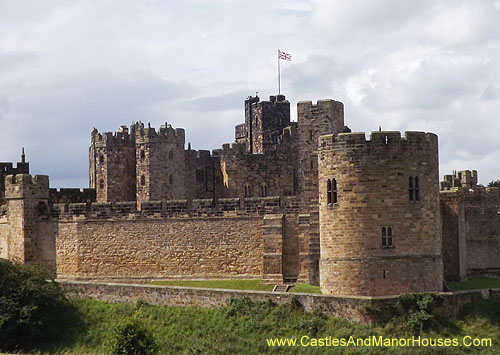
|
Alnwick Castle, Alnwick, Northumberland, England.
Alnwick is a castle and stately home. It is the seat of the Duke of Northumberland, built following the Norman conquest, remodelled a number of times over the last thousand years. It is a Grade I listed building. |
||||||||
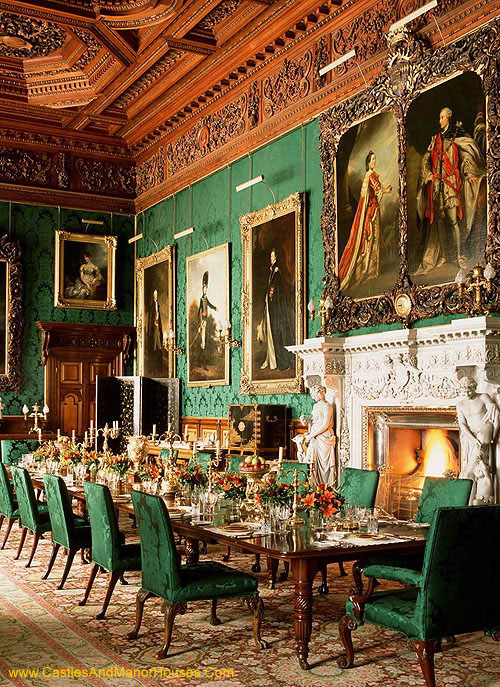 |
State dining room Alnwick Castle Alnwick, Northumberland, England.
Alnwick is a castle and stately home. It is the seat of the Duke of Northumberland, built following the Norman conquest, remodelled a number of times over the last thousand years. It is a Grade I listed building. |
||||||||
 |
Arundel Castle Arundel, West Sussex, England.
Arundel Castle is a restored medieval castle. It was established by Roger de Montgomery on Christmas Day 1067. Roger became the first to hold the earldom of Arundel under William the Conqueror.
The castle was damaged in the English Civil War and then restored in the 18th and 19th centuries.
From the 11th century onward, the castle has served as a hereditary stately home and has been in the family of the Duke of Norfolk for over 400 years. The castle was damaged in the English Civil War and then restored in the 18th and 19th centuries. It is still the principal seat of the Norfolk family. It is a Grade I listed building |
||||||||
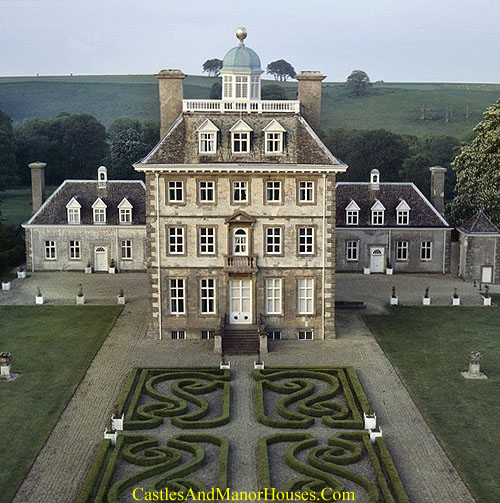 |
Ashdown House Oxford, England |
||||||||
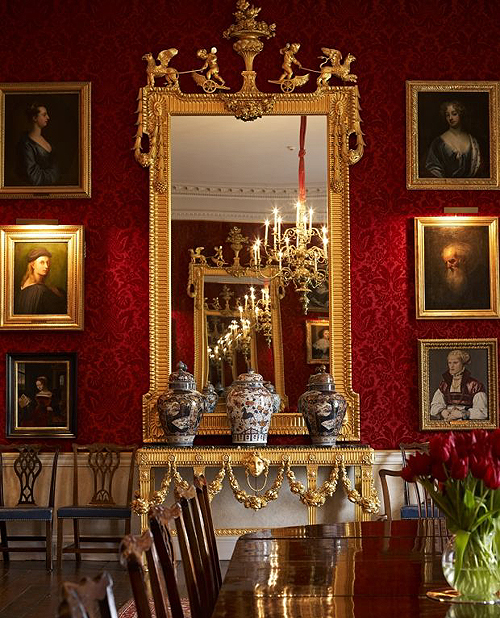 |
The Great Room Althorp Northamptonshire, England
Althorp is a country estate of about 14,000 acres (60 square km) and a Grade I listed stately home in. It is about 5 miles (8.0 km) north-west of the county town of Northampton.
It is the official residence of The Earl and Countess Spencer. It was the home of Diana, Princess of Wales before her marriage to Charles, Prince of Wales. |
||||||||
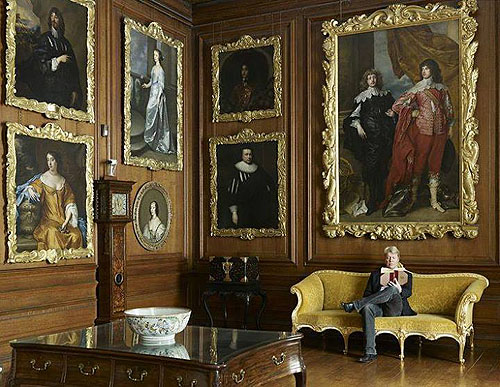 |
Gallery Althorp Northamptonshire, England
Althorp is a country estate of about 14,000 acres (60 square km) and a Grade I listed stately home in. It is about 5 miles (8.0 km) north-west of the county town of Northampton.
It is the official residence of The Earl and Countess Spencer. It was the home of Diana, Princess of Wales before her marriage to Charles, Prince of Wales.
(It's the current Earl Spencer sitting reading the book) |
||||||||
 |
The dining room set for a Regency-era dinner. Attingham Park near Atcham, Shropshire, England.
Attingham Park is a Neoclassical country house and estate, finished in 1785. The Attingham Estate, comprising the mansion and some 650 acres, was gifted to the National Trust in 1947. The house is a Grade I listed building. Attingham Park is now the regional headquarters of the National Trust. |
||||||||
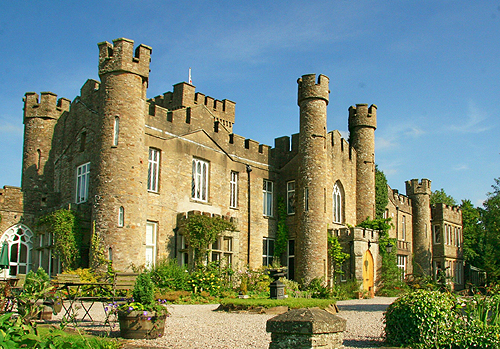 |
Augill Castle Leacetts Lane, Kirkby Stephen, Cumbria CA17 4DE, England |
||||||||
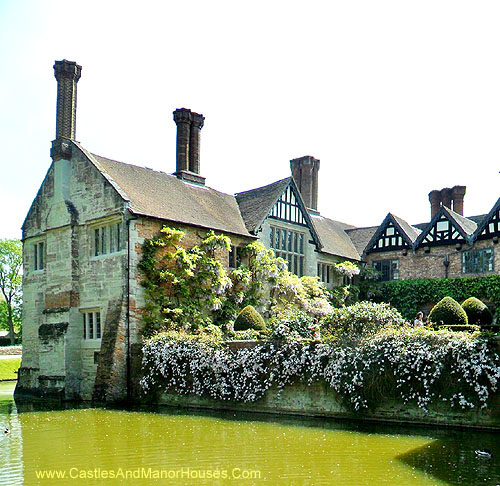 |
Baddesley Clinton Warwickshire, England
Baddesley Clinton is a moated manor house, located just north of the town of Warwick. The house was probably established during the 13th century when large areas of the Forest of Arden were cleared and eventually converted to farmland.
Several priest holes were built, to conceal Catholic agents suspected of treason. One hole is off the Moat Room, a small room with a door hidden in the wood panelling. A second leads into the ceiling, and is reputed to hold six people. A third is hidden in a garderobe. Fugitives could slide down a rope from the first floor through the old garderobe shaft into the house's former sewers, which run the length of the building. These "priest holes" came into use at least once, in 1591 when a conference of Jesuit conspirators was raided by the local authorities.
The site is a Scheduled Ancient Monument and the Hall is a Grade I listed building.
In 1986 exterior shots of Baddesley Clinton were used by Granada Television for their Sherlock Holmes series in The Adventure of the Musgrave Ritual. |
||||||||
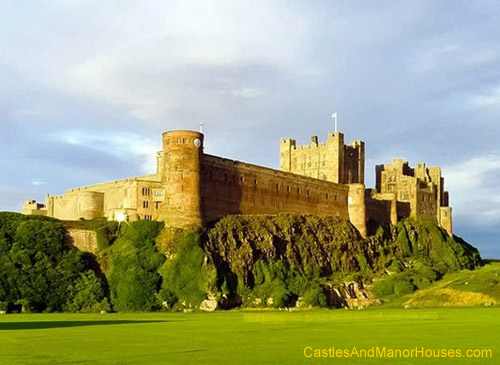 |
Bamburgh Castle Bamburgh, Northumberland, England.
Built on a dolerite outcrop, on the coast, the location was previously the site of a fort of the native Britons known as Din Guarie and may have been the capital of the local British kingdom from the realm's foundation in c.420 until 547. In that year the citadel was captured by the Anglo-Saxon ruler Ida of Bernicia (Beornice) and became Ida's seat. It was briefly retaken by the Britons from his son Hussa during the war of 590 before being relieved later the same year.
The Normans built a new castle on the site, which forms the core of the present one. William II unsuccessfully besieged it in 1095 during a revolt supported by its owner, Robert de Mowbray, Earl of Northumbria. After Robert was captured, his wife continued the defence until forced to surrender by the king's threat to blind her husband. Bamburgh then became the property of the reigning English monarch.
The castle now belongs to the Armstrong family, and is opened to the public. It has been used as a film location since the 1920s, featuring in films such as Ivanhoe (1952), El Cid (1961), Mary, Queen of Scots (1971), and Elizabeth (1998).It is a Grade I listed building. |
||||||||
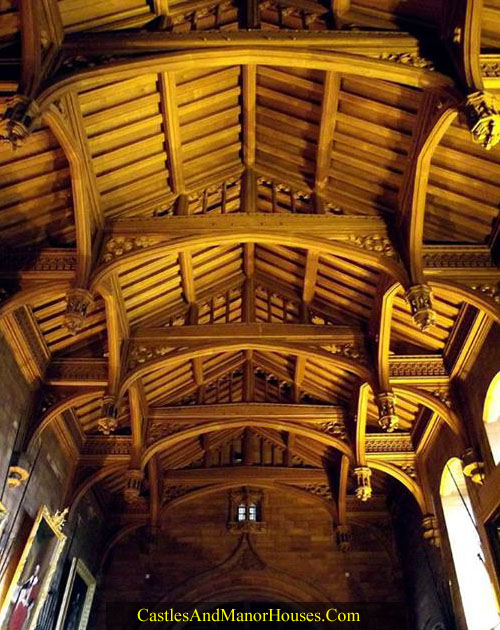 |
Bamburgh Castle, Bamburgh, Northumberland, England. Bamburgh Castle Bamburgh, Northumberland, ENGLAND.
Built on a dolerite outcrop, on the coast, the location was previously the site of a fort of the native Britons known as Din Guarie and may have been the capital of the local British kingdom from the realm's foundation in c.420 until 547. In that year the citadel was captured by the Anglo-Saxon ruler Ida of Bernicia (Beornice) and became Ida's seat. It was briefly retaken by the Britons from his son Hussa during the war of 590 before being relieved later the same year.
The Normans built a new castle on the site, which forms the core of the present one. William II unsuccessfully besieged it in 1095 during a revolt supported by its owner, Robert de Mowbray, Earl of Northumbria. After Robert was captured, his wife continued the defence until forced to surrender by the king's threat to blind her husband. Bamburgh then became the property of the reigning English monarch.
The castle now belongs to the Armstrong family, and is opened to the public. It has been used as a film location since the 1920s, featuring in films such as Ivanhoe (1952), El Cid (1961), Mary, Queen of Scots (1971), and Elizabeth (1998).It is a Grade I listed building. |
||||||||
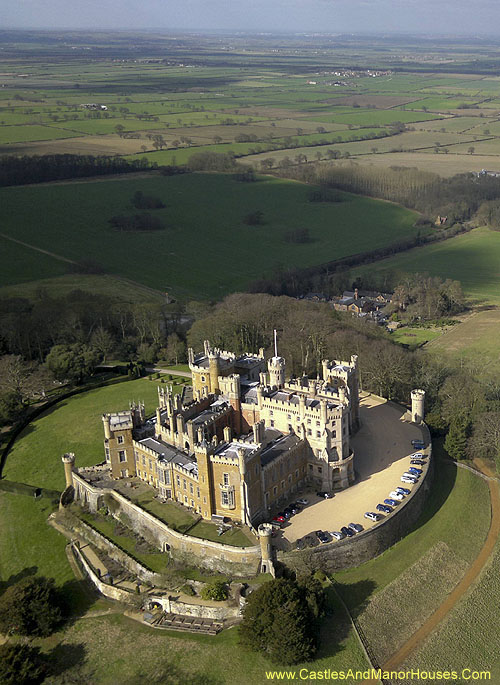 |
Belvoir Castle Leicestershire, England
Belvoir Castle is a stately home, the traditional seat of the Dukes of Rutland, overlooking the Vale of Belvoir. It is a Grade I listed building.
A corner of the castle is still used as the family home of the Manners family and remains the seat of the Dukes of Rutland, most of whom are buried in the grounds of the mausoleum there. |
||||||||
 |
Blenheim Palace Woodstock, Oxfordshire, England
Blenheim Palace is a monumental country house and the principal residence of the dukes of Marlborough. The palace, one of England's largest houses, was built between 1705 and circa 1722. as a reward to John Churchill, 1st Duke of Marlborough, from a grateful nation for the duke's military triumphs against the French and Bavarians during the War of the Spanish Succession, culminating in the 1704 Battle of Blenheim.
Following the palace's completion, it became the home of the Churchill, later Spencer-Churchill, family for the next 300 years. The palace is s the birthplace and ancestral home of Sir Winston Churchill.
It is the only non-royal non-episcopal building in England to hold the title of palace. It was designated a UNESCO World Heritage Site in 1987. |
||||||||
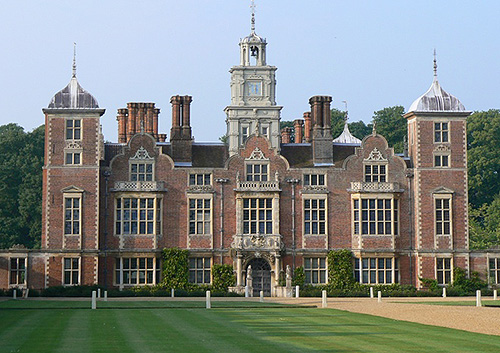 |
Blickling Hall Blickling, Norfolk, England,
In the 15th century, Blickling Hall was in the possession of Sir John Fastolf, who made a fortune in the Hundred Years' War, and whose coat of arms is still on display here.
Later, the Hall came into the possession of the Boleyn family. It was home to Sir Thomas Boleyn, Earl of Wiltshire, the father of Anne Boleyn.
Blickling Hall has been in the care of the National Trust since 1940.
|
||||||||
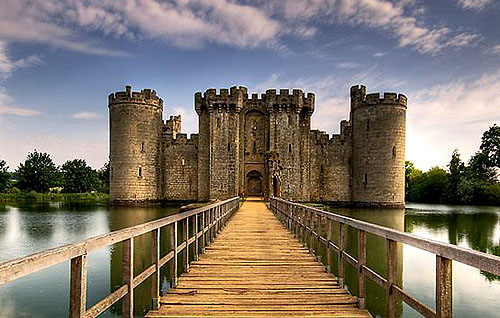
|
Bodiam Castle East Sussex, England
Bodiam Castle is a 14th-century moated castle. It was built in 1385 by Sir Edward Dalyngrigge, a former knight of Edward III, with the permission of Richard II, to defend the area against French invasion during the Hundred Years' War.
Bodiam Castle has a quadrangular plan. It has no keep, having its various chambers built around the outer defensive walls and inner courts. The corners and entrance are marked by towers, topped by crenellations.
It was the home of the Dalyngrigge family and the centre of the manor of Bodiam. The castle is protected as a Grade I listed building and Scheduled Monument. It has been owned by The National Trust since 1925, when it was donated by Lord Curzon on his death. It is open to the public. |
||||||||
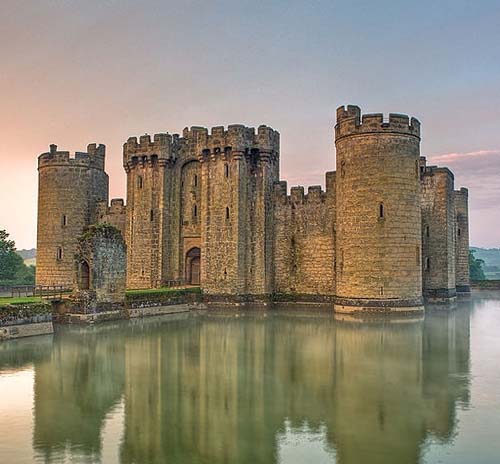 |
Bodiam Castle East Sussex, England
Bodiam Castle is a 14th-century moated castle. It was built in 1385 by Sir Edward Dalyngrigge, a former knight of Edward III, with the permission of Richard II, to defend the area against French invasion during the Hundred Years' War.
Bodiam Castle has a quadrangular plan. It has no keep, having its various chambers built around the outer defensive walls and inner courts. The corners and entrance are marked by crenellated towers.
It was the home of the Dalyngrigge family and the centre of the manor of Bodiam. The castle is protected as a Grade I listed building and Scheduled Monument. It has been owned by The National Trust since 1925, having been donated by Lord Curzon on his death. It is open to the public. |
||||||||
 |
Bodiam Castle East Sussex, England
Bodiam Castle is a 14th-century moated castle. It was built in 1385 by Sir Edward Dalyngrigge, a former knight of Edward III, with the permission of Richard II, to defend the area against French invasion during the Hundred Years' War.
Bodiam Castle has a quadrangular plan. It has no keep, having its various chambers built around the outer defensive walls and inner courts. The corners and entrance are marked by towers, topped by crenellations.
It was the home of the Dalyngrigge family and the centre of the manor of Bodiam. The castle is protected as a Grade I listed building and Scheduled Monument. It has been owned by The National Trust since 1925, when it was donated by Lord Curzon on his death. It is open to the public. |
||||||||
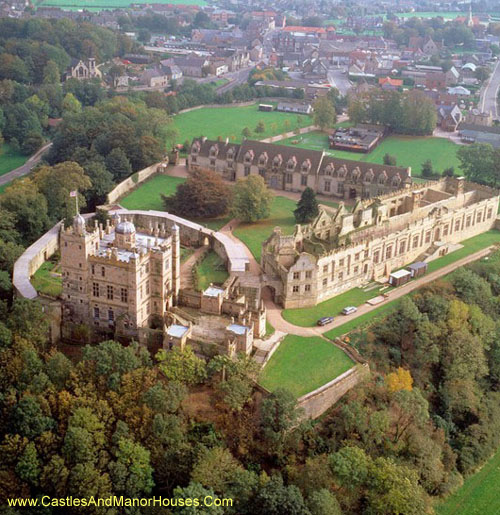 |
Bolsover Castle Bolsover, Derbyshire, England
.Bolsover Castle was founded in the 12th century by the Peverel family, who also owned Peveril Castle in Derbyshire. The site is now in the care of English Heritage and is a Grade I listed building and a Scheduled Ancient Monument. |
||||||||
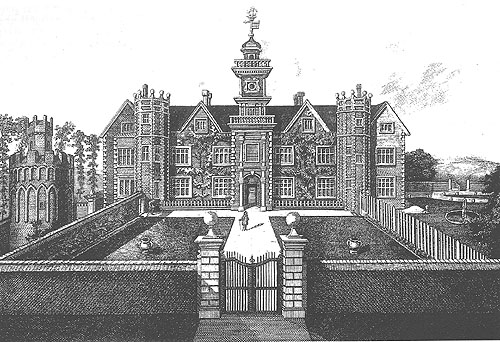 |
Bruce Castle (Lordship House) Lordship Lane, Tottenham, London, England
Bruce Castle (formerly the Lordship House) is a Grade I listed 16th-century manor house.. It is named after the House of Bruce who formerly owned the land on which it is built. The current house is one of the oldest surviving English brick houses. It was remodelled in the 17th, 18th and 19th centuries.
The building also houses the archives of the London Borough of Haringey. Since 1892 the grounds have been a public park. |
||||||||
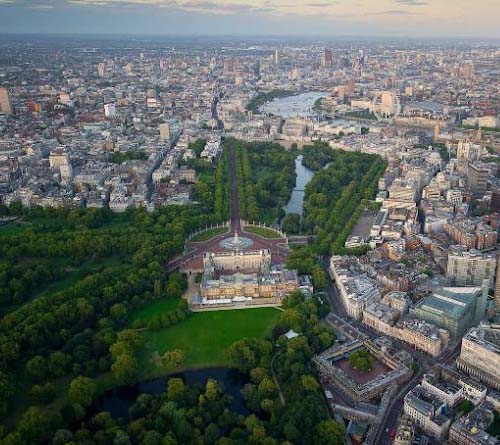 |
Buckingham Palace, Westminster, London, England
Buckingham Palace is the official London residence and principal workplace of the monarch of the United Kingdom.. The palace is often at the centre of state occasions and royal hospitality. It is also a focus at times of national rejoicing.
Originally known as Buckingham House, the building which forms the core of today's palace was a large townhouse built for the Duke of Buckingham in 1703.
It was acquired by King George III in 1761 as a private residence for Queen Charlotte and was then known as "The Queen's House". |
||||||||
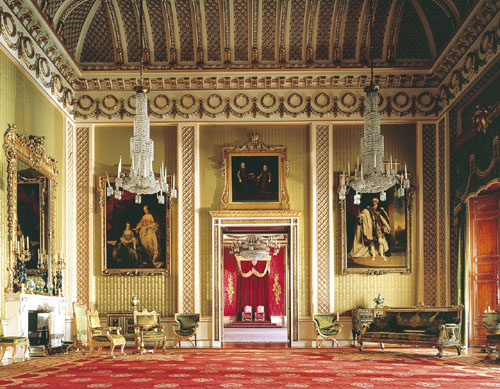 |
Buckingham Palace, Westminster, London, England.
Buckingham Palace is the official London residence and principal workplace of the monarchy of the United Kingdom. The palace is often at the centre of state occasions and royal hospitality. It has been a focus at times of national rejoicing.
Originally known as Buckingham House, the building which forms the core of today’s palace was a large townhouse built for the Duke of Buckingham in 1703. It was acquired by King George III in 1761 as a private residence for Queen Charlotte and was then known as “The Queen’s House”. |
||||||||
 |
Grand Staircase Buckingham Palace London, England |
||||||||
 |
Tower ceiling Canterbury Cathedral, Canterbury, Kent, England
Canterbury Cathedral is one of the oldest and most famous Christian structures in England and forms part of a World Heritage Site. It is the cathedral of the Archbishop of Canterbury, leader of the Church of England and symbolic leader of the worldwide Anglican Communion. |
||||||||
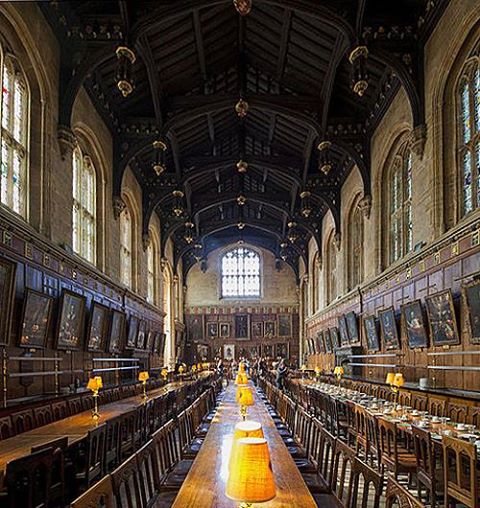 |
The Hall Christ Church College Oxford, England.
The Hall is a vestige of the main room in castles and other great medieval buildings (such as Westminster Hall). All traditional Oxford and Cambridge Colleges have them - the colleges have retained the tradition of everyone eating together, as have the Inns of Court and many public (ie private) schools. Such halls are often now called Great Halls or Dining Halls since the idea of a hall has changed to no more than an entrance or vestibule. ("Refectories" are for monasteries and aspirational modern institutions)
The tables here have individual seats rather than the traditional benches. Until recently, before Health and Safety moved in, it was normal practice for undergraduates to walk over the tables to get to their benches on the other side of the table. You can just see the High Table at the far end.
Christ Church College is usually called just Christ Church, or for those in the know "The House". It was originally called Cardinal's College after its founder Cardinal Wolsey. It still bears his arms. It has a certain prestige - it was re-founded by Henry VIII, it has produced 13 British Prime Ministers and its chapel is a cathedral.
The hall here was used as a model for the hall at Hogwarts in the Harry Potter films. The college is the setting for parts of Evelyn Waugh's Brideshead Revisited, as well as part of Lewis Carroll's Alice's Adventures in Wonderland, and also the film adaptation of Philip Pullman's novel Northern Lights. |
||||||||
 |
Conisbrough Castle Conisbrough, South Yorkshire, England.
Conisbrough Castle is a 12th-century castle, whose remains are dominated by the 97-foot (29.5m) high circular keep, supported by six buttresses. It is shown here as it would have looked before falling into ruin.
The site, strategically placed in one of few historic crossings of the River Don, has been home to a fortification since at least 600 AD. It belonged to one of the seven English kings, prior to the unification of England.
In the mid-1990s, the keep was restored, The building is one of South Yorkshire's primary tourist attractions. It is managed by English Heritage. |
||||||||
 |
Design for a 'Device Fort' or 'Henrician Castle'.
Castle design for King Henry VIII for a castle to defend the South Coast of England.
|
||||||||
 |
Deal Castle, Deal, Kent, England.
One of the most impressive of the Device Forts or Henrician Castles built by Henry VIII between 1539 and 1540 as an artillery fortress to counter the threat of invasion, brought about by the alliance between Charles V, Holy Roman Emperor and King Francis I of France in 1538. |
||||||||
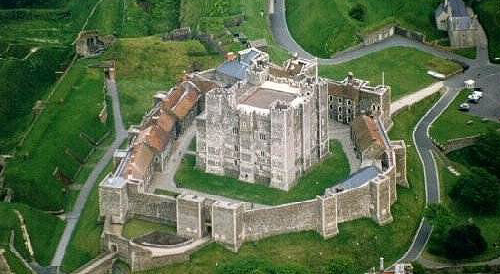 |
Dover Castle Dover, Kent, England.
Dover Castle was founded in the 12th century and has been described as the "Key to England" due to its defensive significance. It is the largest castle in England.
During the reign of Henry II t the castle began to take recognisable shape. The inner and outer baileys and the great keep belong to this time. Maurice the Engineer was responsible for building the keep, one of the last rectangular keeps ever built.
Dover Castle is a Scheduled Monument and a Grade I listed building. The castle, its secret tunnels, and surrounding land are owned by English Heritage and the site is a major tourist attraction.
From the Cinque Ports foundation in 1050, Dover has always been a chief member. The Lord Warden of the Cinque Ports is officially head of the castle, in his conjoint position of Constable of Dover Castle, and the Deputy Constable has his residence in Constable's Gate. |
||||||||
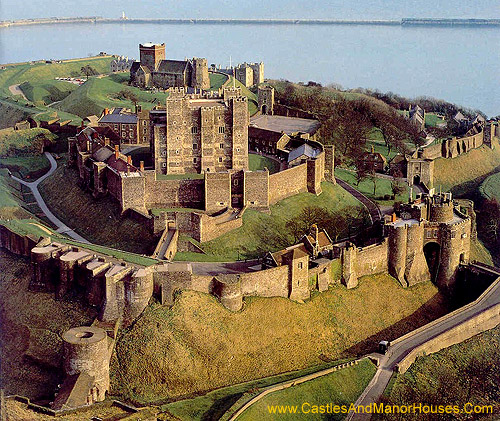 |
Dover Castle Dover, Kent, England.
Dover Castle was founded in the 12th century and has been described as the "Key to England" due to its defensive significance. It is the largest castle in England.
During the reign of Henry II t the castle began to take recognisable shape. The inner and outer baileys and the great keep belong to this time. Maurice the Engineer was responsible for building the keep, one of the last rectangular keeps ever built.
Dover Castle is a Scheduled Monument and a Grade I listed building. The castle, its secret tunnels, and surrounding land are owned by English Heritage and the site is a major tourist attraction.
Dover has always been a chief member of the Cinque Ports since their foundation in 1050. The Lord Warden of the Cinque Ports is officially head of the castle, in his conjoint position of Constable of Dover Castle. The Deputy Constable has his residence in Constable's Gate. |
||||||||
 |
Dover Castle Dover, Kent, England.
Dover Castle was founded in the 12th century and has been described as the "Key to England" due to its defensive significance. It is the largest castle in England.
During the reign of Henry II t the castle began to take recognisable shape. The inner and outer baileys and the great keep belong to this time. Maurice the Engineer was responsible for building the keep, one of the last rectangular keeps ever built.
Dover Castle is a Scheduled Monument and a Grade I listed building. The castle, its secret tunnels, and surrounding land are owned by English Heritage and the site is a major tourist attraction.
From the Cinque Ports foundation in 1050, Dover has always been a chief member. The Lord Warden of the Cinque Ports is officially head of the castle, in his conjoint position of Constable of Dover Castle, and the Deputy Constable has his residence in Constable's Gate. |
||||||||
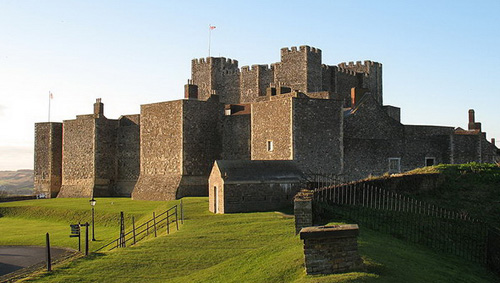 |
Dover Castle Dover, Kent, England.
Dover Castle was founded in the 12th century and has been described as the "Key to England" due to its defensive significance. It is the largest castle in England.
During the reign of Henry II t the castle began to take recognisable shape. The inner and outer baileys and the great keep belong to this time. Maurice the Engineer was responsible for building the keep, one of the last rectangular keeps ever built.
Dover Castle is a Scheduled Monument and a Grade I listed building. The castle, its secret tunnels, and surrounding land are owned by English Heritage and the site is a major tourist attraction.
From the Cinque Ports foundation in 1050, Dover has always been a chief member. The Lord Warden of the Cinque Ports is officially head of the castle, in his conjoint position of Constable of Dover Castle, and the Deputy Constable has his residence in Constable's Gate. |
||||||||
 |
Dover Castle Dover, Kent, England.
Dover Castle was founded in the 12th century and has been described as the "Key to England" due to its defensive significance. It is the largest castle in England.
During the reign of Henry II t the castle began to take recognisable shape. The inner and outer baileys and the great keep belong to this time. Maurice the Engineer was responsible for building the keep, one of the last rectangular keeps ever built.
Dover Castle is a Scheduled Monument and a Grade I listed building. The castle, its secret tunnels, and surrounding land are owned by English Heritage and the site is a major tourist attraction.
From the Cinque Ports foundation in 1050, Dover has always been a chief member. The Lord Warden of the Cinque Ports is officially head of the castle, in his conjoint position of Constable of Dover Castle, and the Deputy Constable has his residence in Constable's Gate. |
||||||||
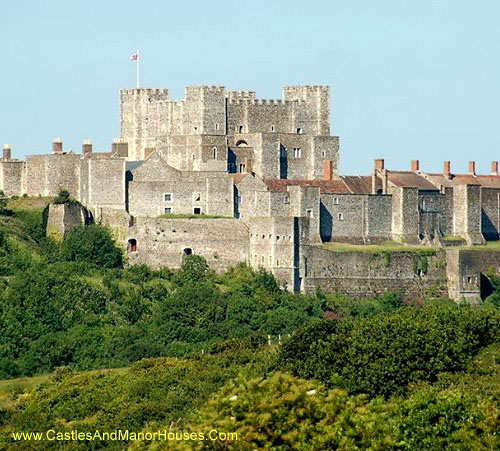 |
Dover Castle Dover, Kent, England.
Dover Castle was founded in the 12th century and has been described as the "Key to England" due to its defensive significance. It is the largest castle in England.
During the reign of Henry II t the castle began to take recognisable shape. The inner and outer baileys and the great keep belong to this time. Maurice the Engineer was responsible for building the keep, one of the last rectangular keeps ever built.
Dover Castle is a Scheduled Monument and a Grade I listed building. The castle, its secret tunnels, and surrounding land are owned by English Heritage and the site is a major tourist attraction.
From the Cinque Ports foundation in 1050, Dover has always been a chief member. The Lord Warden of the Cinque Ports is officially head of the castle, in his conjoint position of Constable of Dover Castle, and the Deputy Constable has his residence in Constable's Gate. |
||||||||
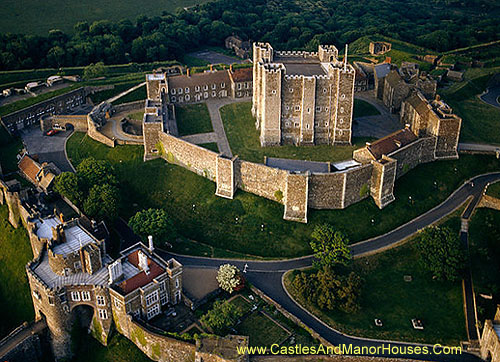 |
Dover Castle Dover, Kent, England.
Dover Castle was founded in the 12th century and has been described as the "Key to England" due to its defensive significance. It is the largest castle in England.
During the reign of Henry II t the castle began to take recognisable shape. The inner and outer baileys and the great keep belong to this time. Maurice the Engineer was responsible for building the keep, one of the last rectangular keeps ever built.
Dover Castle is a Scheduled Monument and a Grade I listed building. The castle, its secret tunnels, and surrounding land are owned by English Heritage and the site is a major tourist attraction.
From the Cinque Ports foundation in 1050, Dover has always been a chief member. The Lord Warden of the Cinque Ports is officially head of the castle, in his conjoint position of Constable of Dover Castle, and the Deputy Constable has his residence in Constable's Gate. |
||||||||
 |
Dover Castle Dover, Kent, England.
Dover Castle was founded in the 12th century and has been described as the "Key to England" due to its defensive significance. It is the largest castle in England.
During the reign of Henry II t the castle began to take recognisable shape. The inner and outer baileys and the great keep belong to this time. Maurice the Engineer was responsible for building the keep, one of the last rectangular keeps ever built.
Dover Castle is a Scheduled Monument and a Grade I listed building. The castle, its secret tunnels, and surrounding land are owned by English Heritage and the site is a major tourist attraction.
From the Cinque Ports foundation in 1050, Dover has always been a chief member. The Lord Warden of the Cinque Ports is officially head of the castle, in his conjoint position of Constable of Dover Castle, and the Deputy Constable has his residence in Constable's Gate. |
||||||||
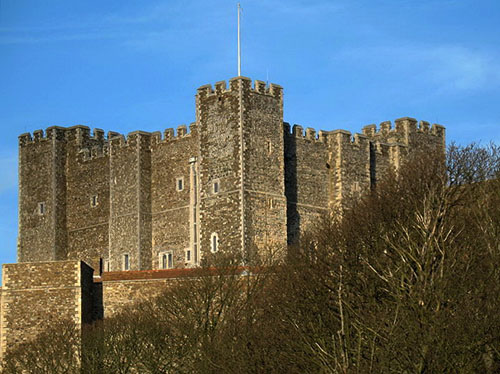 |
Dover Castle Dover, Kent, England.
Dover Castle was founded in the 12th century and has been described as the "Key to England" due to its defensive significance. It is the largest castle in England.
During the reign of Henry II t the castle began to take recognisable shape. The inner and outer baileys and the great keep belong to this time. Maurice the Engineer was responsible for building the keep, one of the last rectangular keeps ever built.
Dover Castle is a Scheduled Monument and a Grade I listed building. The castle, its secret tunnels, and surrounding land are owned by English Heritage and the site is a major tourist attraction.
From the Cinque Ports foundation in 1050, Dover has always been a chief member. The Lord Warden of the Cinque Ports is officially head of the castle, in his conjoint position of Constable of Dover Castle, and the Deputy Constable has his residence in Constable's Gate. |
||||||||
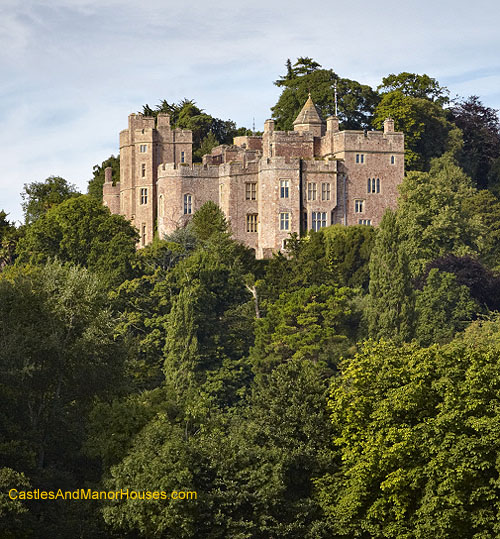 |
Dunster Castle Dunster, Somerset, England.
Dunster Castle is a former motte and bailey castle, now a country house, sited on top of a Tor. The site has been fortified since the late Anglo-Saxon period.
A stone shell keep was built on the motte by the start of the 12th century, and the castle survived a siege during the early years of the Anarchy. At the end of the 14th century the de Mohuns sold the castle to the Luttrell family, who continued to occupy the property until the late 20th century.
The castle was expanded several times by the Luttrell family during the 17th and 18th centuries; they built a large manor house within the Lower Ward of the castle in 1617.
The medieval castle walls were mostly destroyed following the siege of Dunster Castle at the end of the English Civil War, when Parliament ordered the defences to be slighted to prevent their further use.
In the 1860s and 1870s the castle was remodelled to Victorian tastes.
In 1976 Colonel Walter Luttrell gave Dunster Castle and most of its contents to the National Trust, which now operates it as a tourist attraction. It is a Grade I listed building and scheduled monument. |
||||||||
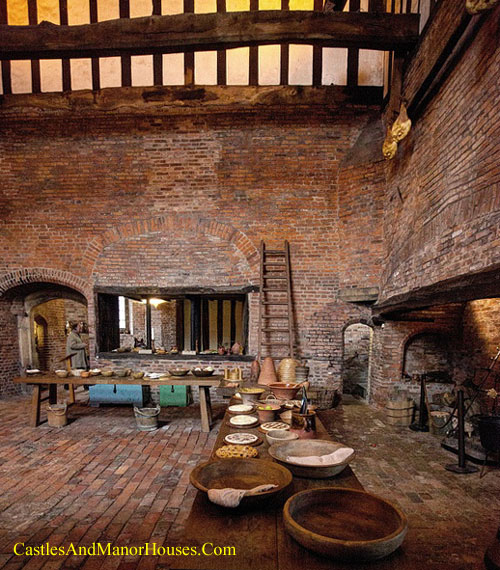 |
Medieval Kitchen Gainsborough Old Hall Gainsborough, Lincolnshire, England.
The hall was built by Sir Thomas Burgh in 1460. In 1484 Sir Thomas entertained King Richard III in his hall. King Henry VIII visited Gainsborough twice; once in 1509 and again in 1541 with the doomed Queen Catherine Howard. The Queen was accused of indiscretions both at Gainsborough and nearby Lincoln, for which she was executed.
The Old Hall has changed very little over the years. It is principally a timber framed building, giving it its characteristic 'striped' or 'black and white' appearance. On the north east corner is a brick tower. The Hall with its elaborate timber roof survives as well as the kitchen—possibly the most complete medieval kitchen in England. The kitchen still contains many original features, including two open fireplaces, each large enough to roast an ox, and two bread ovens served by a third chimney.
Unfortunately some philistine has built an ugly council estate right next to the Hall. The Hall is now owned by English Heritage and is open to the public as a museum. It is listed as Grade I for Heritage Protection. |
||||||||
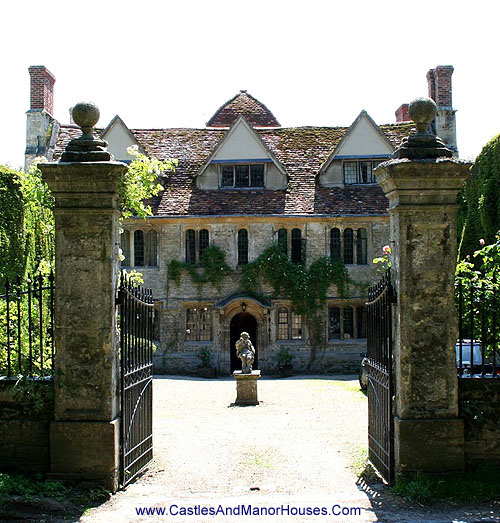 |
Garsington Manor Garsington, near Oxford, England
Garsington Manor is a Tudor building, built on land once owned by the son of the poet Geoffrey Chaucer. At one time it was called “Chaucers”.
Lady Ottoline and her husband, Philip Morrell, bought the manor house in 1914.They restored the house and Garsington became a haven for the Morrells’ friends, including D. H. Lawrence, Siegfried Sassoon, Lytton Strachey, Aldous Huxley, Mark Gertler, and Bertrand Russell. |
||||||||
 |
Ham House Ham, London, England.
Ham House is situated beside the River Thames south of Richmond. It is claimed by the National Trust to be “unique in Europe as the most complete survival of 17th century fashion and power.” |
||||||||
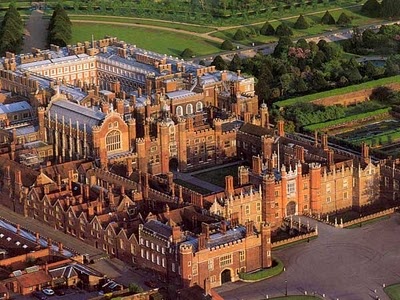 |
Hampton Court Palace Richmond upon Thames Greater London England |
||||||||
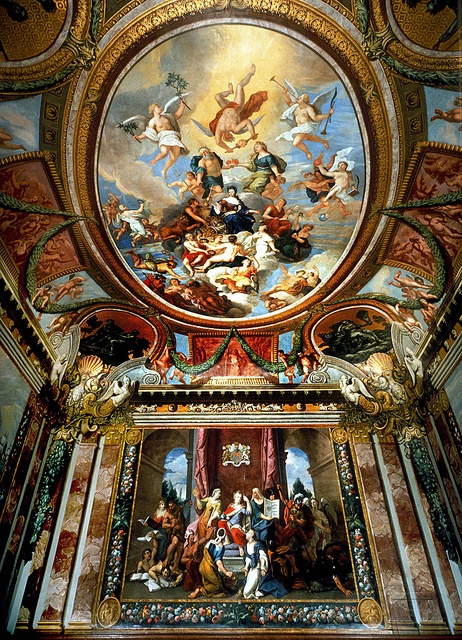 |
Ceiling, Queen's Drawing Room Hampton Court Palace East Molesey, Surrey KT8 9AU, England
The palace was built for Cardinal Thomas Wolsey, a favourite of King Henry VIII, on the river Thames in Richmond upon Thames, in the historic county of Middlesex.
When Wolsey fell from favour in 1529, the palace was ceded to the King.Hampton Court Palace then became a royal palace
The palace has not been inhabited by the British Royal Family since the 18th century.
|
||||||||
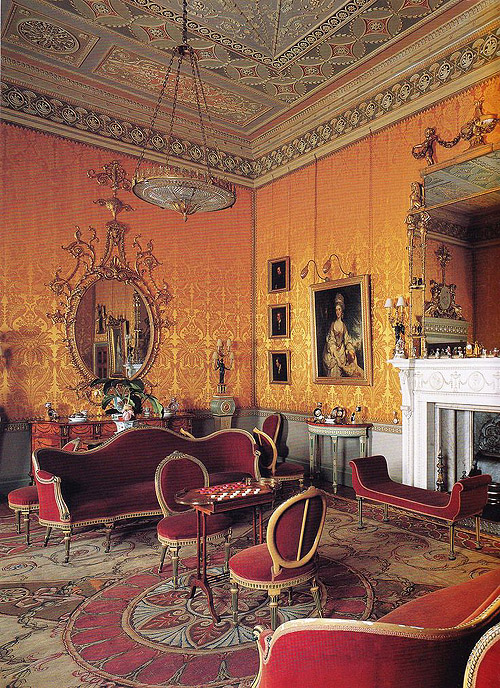 |
Yellow Drawing Room circa 1759. Harewood House Harewood near Leeds, West Yorkshire, England
Harewood House is a country house idesigned by architects John Carr and Robert Adam. It was built from 1759 to 1771 for Edwin Lascelles, 1st Baron Harewood.
Much of the furniture is by the eighteenth-century English furniture designer Thomas Chippendale, who came from nearby Otley.
Lancelot "Capability" Brown designed the grounds to which Sir Charles Barry added a grand terrace, in 1844. Artists Thomas Girtin and JMW Turner stayed at the house many times, painting the house itself and also the surrounding countryside and landmarks owned by the Harewood Estate.
The house is still home to the Lascelles family. It is a Grade I listed building; with a number of features in the grounds and courtyard also listed as Grade I, II and II* |
||||||||
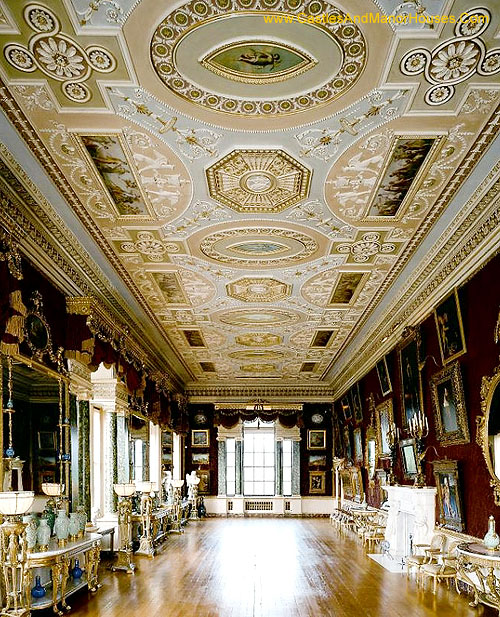 |
Harewood House Harewood near Leeds, West Yorkshire, England
Harewood House is a country house idesigned by architects John Carr and Robert Adam. It was built between 1759 and 1771 for Edwin Lascelles, 1st Baron Harwood.
Much of the furniture is by the eighteenth-century English furniture designer Thomas Chippendale, who came from nearby Otley.
Lancelot "Capability" Brown designed the grounds to which Sir Charles Barry added a grand terrace, in 1844. Artists Thomas Girtin and JMW Turner stayed at the house many times, painting the house itself and also the surrounding countryside and landmarks owned by the Harewood Estate.
The house is still home to the Lascelles family. It is a Grade I listed building; with a number of features in the grounds and courtyard also listed as Grade I, II and II* |
||||||||
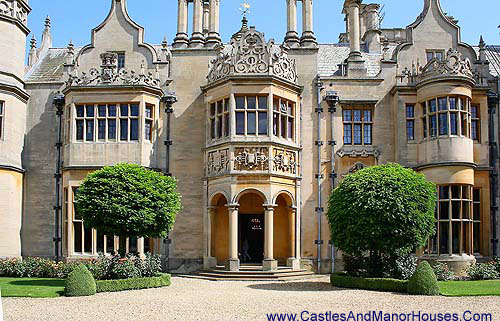 |
Harlaxton Manor Harlaxton, Lincolnshire, England
Harlaxton Manor, built in 1837, is a manor house which combines elements of Jacobean and Elizabethan styles with symmetrical Baroque massing.
The manor is a popular location for filming. Exterior and interior shots have been featured in the films The Ruling Class, The Last Days of Patton, The Lady and the Highwayman, The Haunting, and The Young Visiters.
It is now part of the University of Evansville's British campus. |
||||||||
 |
The Great Hall Hatfield House Great North Rd, Hatfield, Hertfordshire AL9 5NQ, England
Hatfield House is a country house set in a large park, to the east of Hatfield, Hertfordshire, England. It is a prime example of Jacobean architecture
The present Jacobean house was built in 1611 by Robert Cecil, First Earl of Salisbury and Chief Minister to King James I and has been the home of the Cecil family ever since.
Hatfield House is currently the home of Robert Gascoyne-Cecil, 7th Marquess of Salisbury.
The house is open to the public
|
||||||||
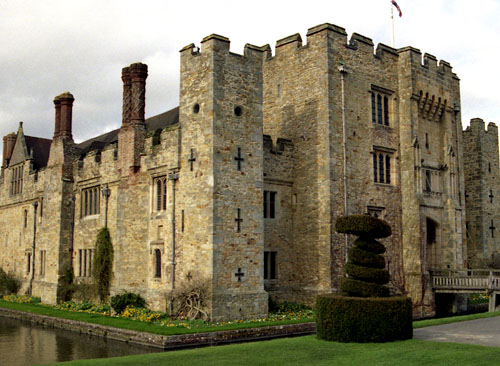 |
Hever Castle Hever, Kent, near Edenbridge,England.
Hever Castle began as a country house, built in the 13th century.
From 1462 to 1539 it was the seat of the 'Bullen', family later known as the Boleyn family. Anne Boleyn, the second queen consort of King Henry VIII of England, spent her early youth there, after her father, Thomas Boleyn had inherited it in 1505.
It later came into the possession of King Henry VIII's fourth wife, Anne of Cleves.
The castle is now a tourist attraction. |
||||||||
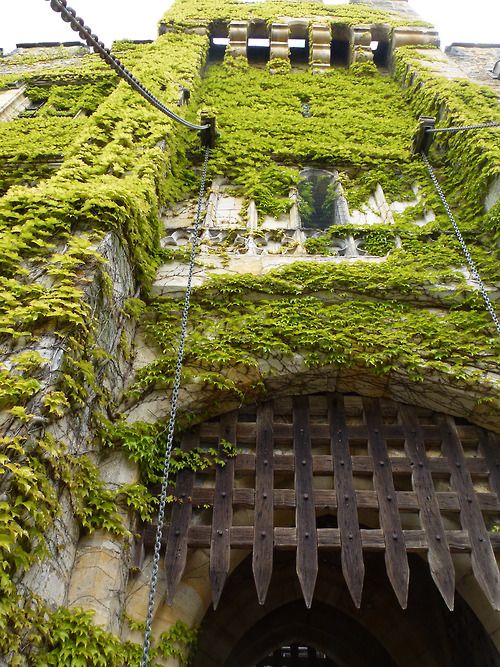 |
Hever Castle Hever, Edenbridge, Kent TN8 7NG, England.
Hever Castle began as a country house, built in the 13th century. From 1462 to 1539 it was the seat of the Bullen (later Boleyn family.
Anne Boleyn, the second queen consort of King Henry VIII , spent her early youth there, after her father, Thomas Boleyn had inherited it in 1505.
It later came into the possession of King Henry's fourth wife, Anne of Cleves.
The castle is now a major tourist attraction. |
||||||||
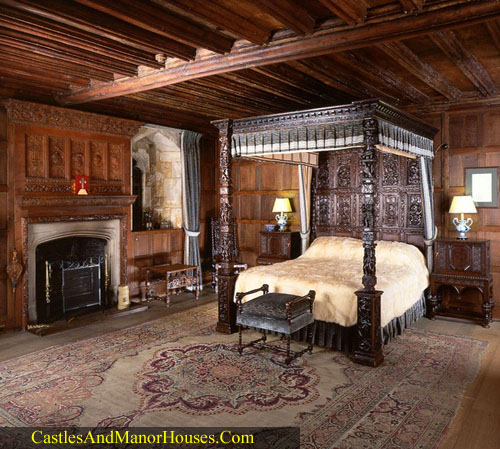 |
Tudor Bedroom Hever Castle Hever, Edenbridge, Kent TN8 7NG, ENGLAND.
Hever Castle began as a country house, built in the 13th century. From 1462 to 1539 it was the seat of the Bullen (later Boleyn family.
Anne Boleyn, the second queen consort of King Henry VIII , spent her early youth there, after her father, Thomas Boleyn had inherited it in 1505.
It later came into the possession of King Henry's fourth wife, Anne of Cleves.
The castle is now a major tourist attraction. |
||||||||
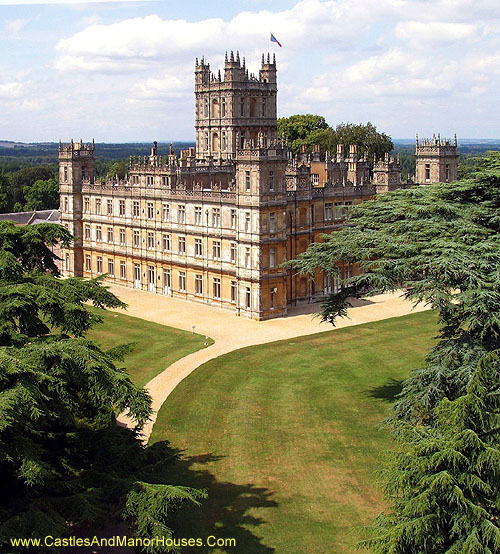 |
Highclere Castle Hampshire, England,
Highclere Castle is a country house in the Jacobethan style, with a park designed by Capability Brown. It is the country seat of the Earl of Carnarvon, head of a branch of the Anglo-Welsh Herbert family.
Highclere Castle is the main filming location for the British television period drama Downton Abbey.
The Castle and gardens are open to the public during July and August and at times during the rest of the year. |
||||||||
 |
Highclere Castle Hampshire, ENGLAND,
Highclere Castle is a country house in the Jacobethan style, with a park designed by Capability Brown. It is the country seat of the Earl of Carnarvon, head of a branch of the Anglo-Welsh Herbert family.
Highclere Castle is the main filming location for the British television period drama Downton Abbey.
The Castle and gardens are open to the public during July and August and at times during the rest of the year. |
||||||||
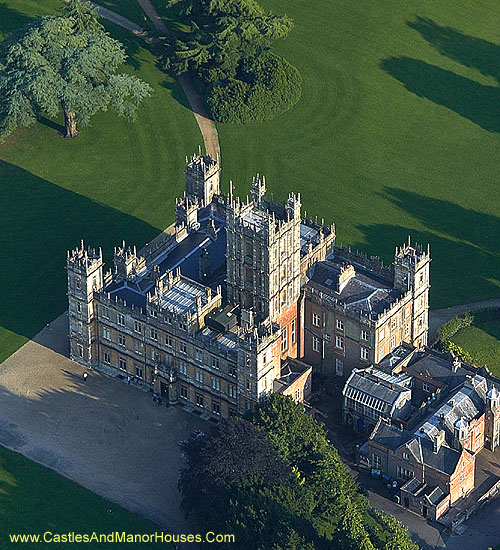 |
Highclere Castle Hampshire, England.
Highclere Castle is a country house in the Jacobethan style, with a park designed by Capability Brown. It is the country seat of the Earl of Carnarvon, head of a branch of the Anglo-Welsh Herbert family.
Highclere Castle is the main filming location for the British television period drama Downton Abbey.
The Castle and gardens are open to the public during July and August and at times during the rest of the year. |
||||||||
 |
Thyme Walk Highgrove House Doughton, Gloucestershire, England
Highgrove House is the country home of Prince Charles, situated southwest of Tetbury. Highgrove House was purchased in 1980 by the Duchy of Cornwall which manages the house and the estate surrounding the house.. |
||||||||
 |
Castle Howard North Yorkshire, England.
Castle Howard is not a castle, but an English country house erected on the site of a former military castle. It is located 15 miles (24 km) north of York. It is a private residence, and has been the home of the Howard family for more than 300 years.
Castle Howard was built between 1699 and 1712 to a design by Sir John Vanbrugh for the 3rd Earl of Carlisle. The site was that of the ruined Henderskelfe Castle, which had come into the Howard family in 1566 through the marriage to Lord Dacre's widow of Thomas, 4th Duke of Norfolk.
The house is surrounded by a large estate which, at the time of the 7th Earl of Carlisle, covered over 13,000 acres (5,300 ha). The estate was served by its own railway station, Castle Howard, from 1845 to the 1950s.
Castle Howard is familiar to television and film audiences as the fictional "Brideshead", both in Granada Television's 1981 adaptation of Evelyn Waugh's Brideshead Revisited and a two-hour 2008 remake for cinema |
||||||||
 |
Castle Howard North Yorkshire England |
||||||||
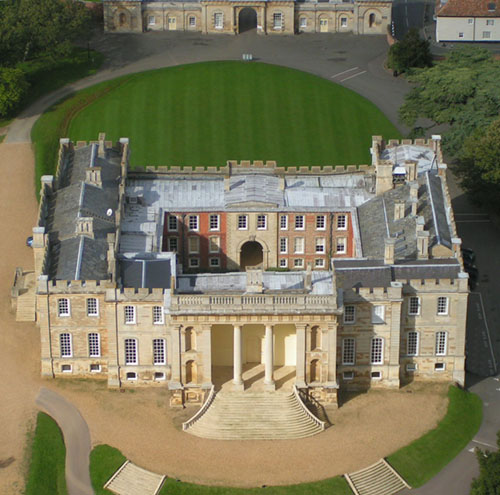 |
Kimbolton Castle Kimbolton, Huntingdonshire district of Cambridgeshire, England
Kimbolton Castle is best known as the final home of King Henry VIII's first queen, Catherine of Aragon. Catherine was sent here in April 1534 for refusing to give up her status or deny the validity of her marriage. The fenland climate damaged her health, and she died here in January 1536. Her body was taken and buried in Peterborough Abbey (now Peterborough Cathedral).
Originally a medieval castle it was converted into a stately palace, it was the family seat of the Dukes of Manchester from 1615 until 1950. It now houses Kimbolton School. |
||||||||
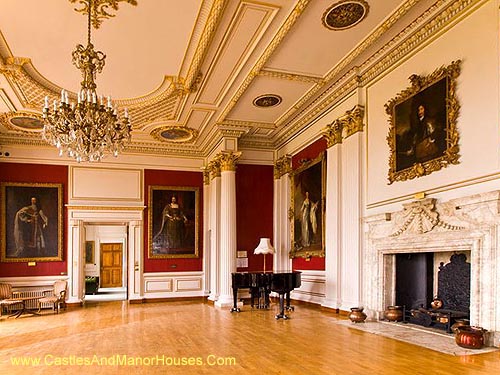 |
Kimbolton Castle Kimbolton, Huntingdonshire, England.
Kimbolton Castle is best known as the final home of King Henry VIII's first queen, Catherine of Aragon. Originally a medieval castle but converted into a stately palace, it was the family seat of the Dukes of Manchester from 1615 until 1950. It now houses Kimbolton School. |
||||||||
 |
Knightshayes Court Tiverton, Devon, England
Knightshayes Court is a Victorian country house, designed by William Burges for the Heathcoat-Amory family.
The house is Grade I listed. |
||||||||
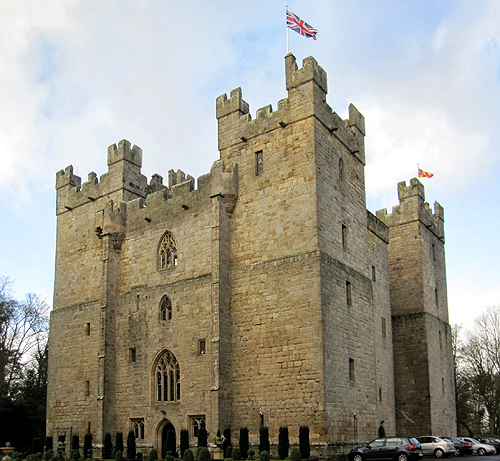 |
Langley Castle Langley, Northumberland, England.
Langley Castle is a restored medieval tower house, situated in the valley of the River South Tyne south of Haydon Bridge,
The south west tower boasts 12 garderobes, four to each floor.
It is a Grade I listed building. |
||||||||
 |
Leeds Castle Kent, England
Leeds Castle is in Kent, England, 5 miles (8 km) Southeast of Maidstone. A castle has been on the site since 1119. In the 13th century it came into the hands of King Edward I, for whom it became a favourite residence; in the 16th century, Henry VIII used it as a residence for his first wife, Catherine of Aragon.
The castle was a location for the 1949 film Kind Hearts and Coronets where it stood in for "Chalfont", the ancestral home of the d'Ascoyne family. The castle also appeared in Moonraker (1958) and Waltz of the Toreadors (1962). It was the set for the Doctor Who episode The Androids of Tara.
The castle today dates mostly from the 19th century and is built on islands in a lake formed by the River Len to the east of the village of Leeds. It has been open to the public since 1976 |
||||||||
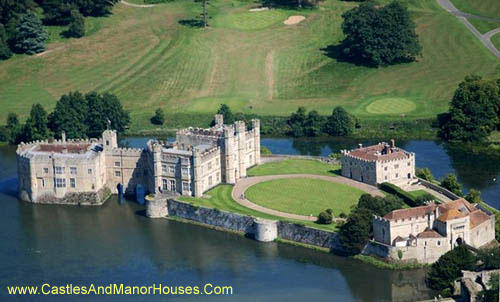 |
Leeds Castle Kent, England
Leeds Castle is in Kent, England, 5 miles (8 km) southeast of Maidstone. A castle has been on the site since 1119. In the 13th century it came into the hands of King Edward I, for whom it became a favourite residence; in the 16th century, Henry VIII used it as a residence for his first wife, Catherine of Aragon.
The castle was a location for the 1949 film Kind Hearts and Coronets where it stood in for "Chalfont", the ancestral home of the d'Ascoyne family. The castle also appeared in Moonraker (1958) and Waltz of the Toreadors (1962). It was the set for the Doctor Who episode The Androids of Tara.
The castle today dates mostly from the 19th century and is built on islands in a lake formed by the River Len to the east of the village of Leeds. It has been open to the public since 1976 |
||||||||
 |
Leeds Castle Kent, England
Leeds Castle is in Kent, England, 5 miles (8 km) southeast of Maidstone. A castle has been on the site since 1119. In the 13th century it came into the hands of King Edward I, for whom it became a favourite residence; in the 16th century, Henry VIII used it as a residence for his first wife, Catherine of Aragon.
The castle was a location for the 1949 film Kind Hearts and Coronets where it stood in for "Chalfont", the ancestral home of the d'Ascoyne family. The castle also appeared in Moonraker (1958) and Waltz of the Toreadors (1962). It was the set for the Doctor Who episode The Androids of Tara.
The castle today dates mostly from the 19th century and is built on islands in a lake formed by the River Len to the east of the village of Leeds. It has been open to the public since 1976 |
||||||||
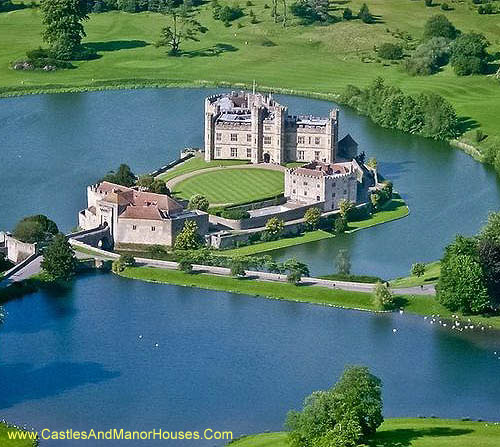 |
Leeds Castle, Kent, England
Leeds Castle is in Kent, England, 5 miles (8 km) southeast of Maidstone. A castle has been on the site since 1119. In the 13th century it came into the hands of King Edward I, for whom it became a favourite residence; in the 16th century, Henry VIII used it as a residence for his first wife, Catherine of Aragon.
The castle was a location for the 1949 film Kind Hearts and Coronets where it stood in for "Chalfont", the ancestral home of the d'Ascoyne family. The castle also appeared in Moonraker (1958) and Waltz of the Toreadors (1962). It was the set for the Doctor Who episode The Androids of Tara.
The castle today dates mostly from the 19th century and is built on islands in a lake formed by the River Len to the east of the village of Leeds. It has been open to the public since 1976 |
||||||||
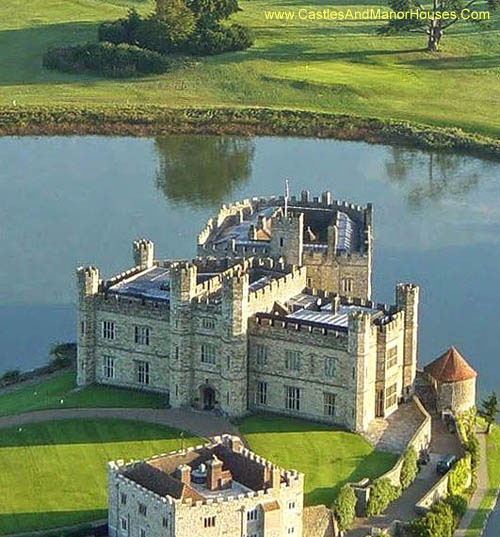 |
Leeds Castle Kent, England
Leeds Castle is in Kent, England, 5 miles (8 km) southeast of Maidstone. A castle has been on the site since 1119. In the 13th century it came into the hands of King Edward I, for whom it became a favourite residence; in the 16th century, Henry VIII used it as a residence for his first wife, Catherine of Aragon.
The castle was a location for the 1949 film Kind Hearts and Coronets where it stood in for "Chalfont", the ancestral home of the d'Ascoyne family. The castle also appeared in Moonraker (1958) and Waltz of the Toreadors (1962). It was the set for the Doctor Who episode The Androids of Tara.
The castle today dates mostly from the 19th century and is built on islands in a lake formed by the River Len to the east of the village of Leeds. It has been open to the public since 1976 |
||||||||
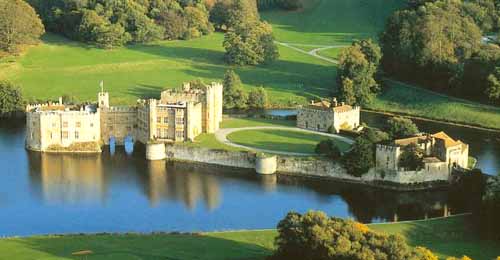 |
Leeds Castle Kent, England
Leeds Castle is in Kent, England, 5 miles (8 km) Southeast of Maidstone. A castle has been on the site since 1119. In the 13th century it came into the hands of King Edward I, for whom it became a favourite residence; in the 16th century, Henry VIII used it as a residence for his first wife, Catherine of Aragon.
The castle was a location for the 1949 film Kind Hearts and Coronets where it stood in for "Chalfont", the ancestral home of the d'Ascoyne family. The castle also appeared in Moonraker (1958) and Waltz of the Toreadors (1962). It was the set for the Doctor Who episode The Androids of Tara.
The castle today dates mostly from the 19th century and is built on islands in a lake formed by the River Len to the east of the village of Leeds. It has been open to the public since 1976 . |
||||||||
 |
Leeds Castle Kent, England
Leeds Castle is in Kent, England, 5 miles (8 km) Southeast of Maidstone. A castle has been on the site since 1119. In the 13th century it came into the hands of King Edward I, for whom it became a favourite residence; in the 16th century, Henry VIII used it as a residence for his first wife, Catherine of Aragon.
The castle was a location for the 1949 film Kind Hearts and Coronets where it stood in for "Chalfont", the ancestral home of the d'Ascoyne family. The castle also appeared in Moonraker (1958) and Waltz of the Toreadors (1962). It was the set for the Doctor Who episode The Androids of Tara.
The castle today dates mostly from the 19th century and is built on islands in a lake formed by the River Len to the east of the village of Leeds. It has been open to the public since 1976 |
||||||||
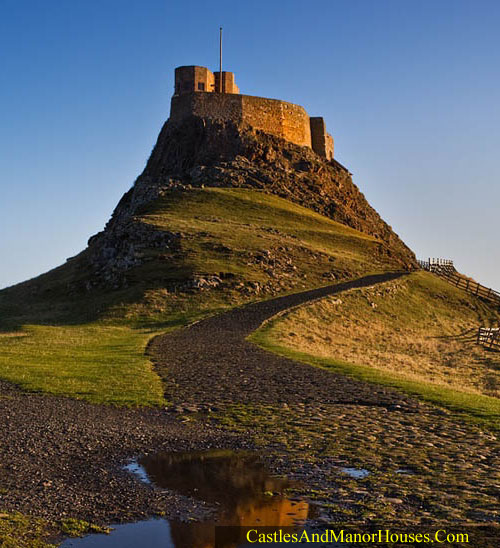 |
Lindisfarne Castle Holy Island, near Berwick-upon-Tweed, Northumberland, England.
Lindisfarne Castle is a 16th-century castle much altered by Sir Edwin Lutyens in 1901. The island is accessible from the mainland at low tide by means of a causeway. The castle is located in what was once the very volatile border area between England and Scotland. Not only did the English and Scots fight, but the area was frequently attacked by Vikings. The castle was built in 1550, around the time that Lindisfarne Priory went out of use, and stones from the priory were used as building material. It is very small by the usual standards, and was more of a fort.
After Henry VIII suppressed the priory here, his troops used the remains as a naval store. In 1542 Henry VIII ordered the Earl of Rutland to fortify the site against possible Scottish invasion. Elizabeth I had further work carried out on the fort, strengthening it and providing gun platforms for the new developments in artillery technology.
In 1901, the castle became the property of Edward Hudson, a publishing magnate and the owner of Country Life magazine. He had it refurbished in the Arts and Crafts style by Sir Edwin Lutyens. |
||||||||
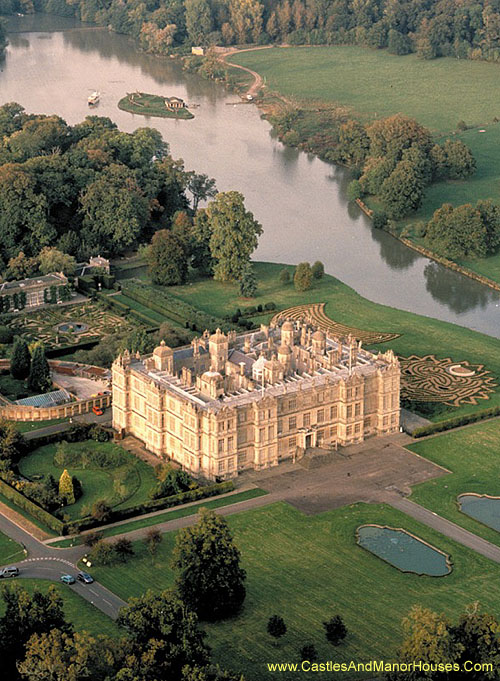 |
Longleat Warminster, Wiltshire BA12 7NW, England.
Longleat is an English stately home and the seat of the Marquesses of Bath. It is noted for its Elizabethan country house, maze, landscaped parkland and safari park. The house is set in parkland landscaped by Capability Brown.
Longleat is occupied by Alexander Thynn, 7th Marquess of Bath. |
||||||||
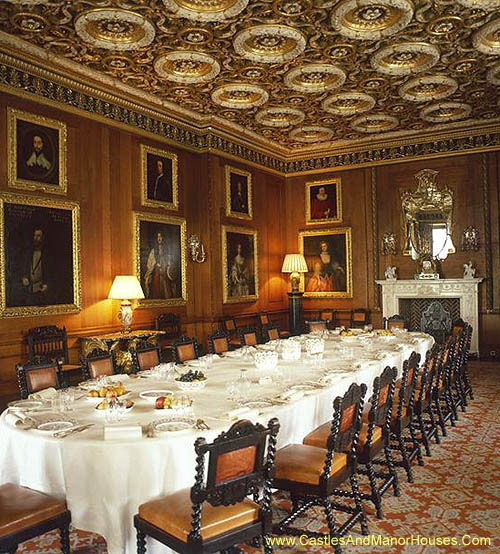 |
Dining Room Longleat House adjacent to the village of Horningsham, Wiltshire, England.
Longleat is an English stately home and the seat of the Marquesses of Bath. It is noted for its Elizabethan country house, maze, landscaped parkland and safari park. The house is set in over 1,000 acres of parkland landscaped by Capability Brown, with 4,000 acres of farmland and 4,000 acres of woodland.
It was the first stately home to open to the public.
Longleat is occupied by Alexander Thynn, 7th Marquess of Bath. |
||||||||
 |
Longleat, Warminster, Wiltshire BA12 7NW, England.
Longleat is an English stately home and the seat of the Marquesses of Bath. It is noted for its Elizabethan country house, maze, landscaped parkland and safari park. The house is set in parkland landscaped by Capability Brown.
Longleat is occupied by Alexander Thynn, 7th Marquess of Bath. |
||||||||
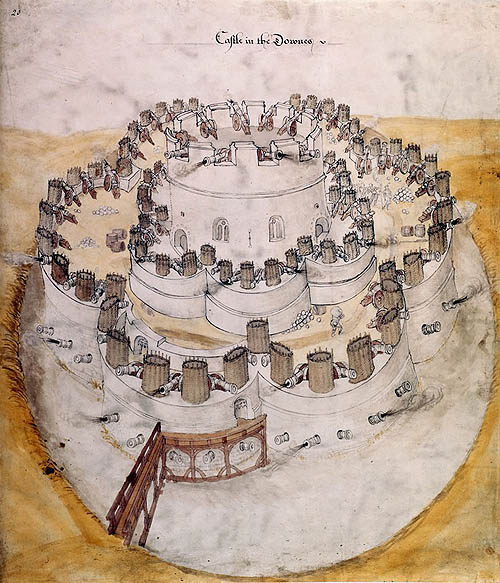 |
Castle design for King Henry VIII for a castle to defend the South Coast of England.
Design for a “Device Fort” or “Henrician Castle”. |
||||||||
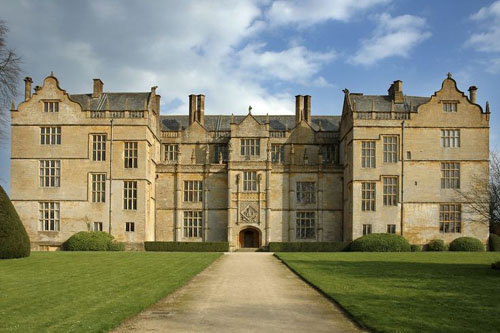 |
Montacute House Montacute, Somerset, England
Montacute House is a late Elizabethan country house typical of English architecture in transition from the medieval Gothic to the Renaissance Classical.
It is one of the finest houses to survive almost unchanged from the Elizabethan era, and has been designated by English Heritage as a Grade I listed building, and Scheduled Ancient Monument.
The house was built in about 1598 by Sir Edward Phelips, Master of the Rolls and the prosecutor during the trial of the Gunpowder Plotters.
Lord Curzon lived at the house with his mistress, the novelist Elinor Glyn. It was acquired by the National Trust in 1927 |
||||||||
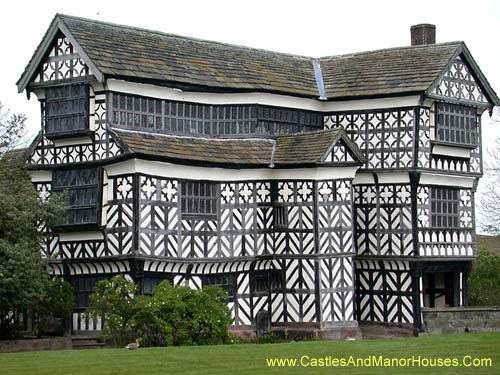 |
Little Moreton Hall 4 miles (6.4 km) southwest of Congleton, Cheshire, England
Little Moreton Hall, also known as Old Moreton Hall, is a moated half-timbered manor house. The earliest parts of the house were built for the prosperous Cheshire landowner William Moreton in about 1504–08, and the remainder was constructed in stages by successive generations of the family until about 1610.
The building is highly irregular, with three asymmetrical ranges forming a small, rectangular cobbled courtyard. The weight of the third-storey glazed gallery, possibly added at a late stage of construction, has caused the lower floors to bow and warp.
The house remained in the possession of the Moreton family for almost 450 years, until ownership was transferred to the National Trust in 1938. Little Moreton Hall and its sandstone bridge across the moat are recorded in the National Heritage List for England as a designated Grade I listed building, and the ground on which Little Moreton Hall stands is protected as a Scheduled Monument. The gardens lay abandoned until their 20th-century re-creation. |
||||||||
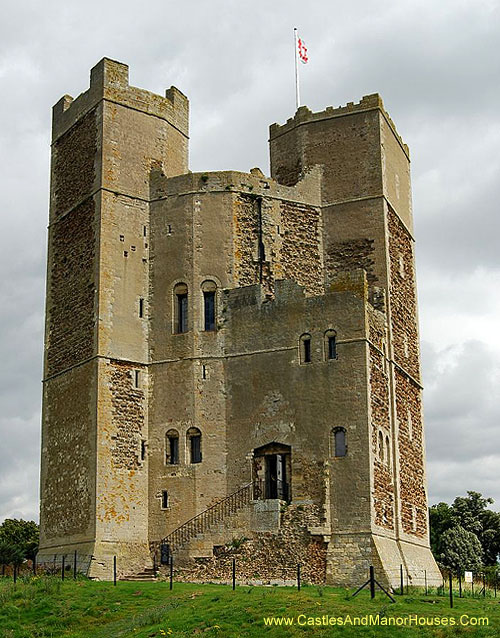 |
Orford Castle Orford, Suffolk, England
Orford Castle was built between 1165 and 1173 by King Henry II of England to consolidate royal power in the region. The well-preserved keep, "one of the most remarkable keeps in England", is of a unique design and probably based on Byzantine architecture (brought back by crusaders). |
||||||||
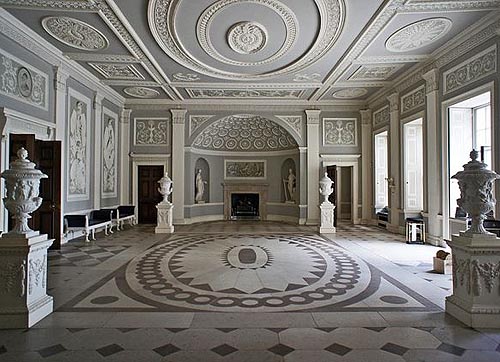 |
Entrance Hall in Osterley House, Hounslow, London, England
Osterley House (or Osterley Park) is a mansion set in a large park. When the house was built it was surrounded by rural countryside.
It was one of a group of large houses close to London which served as country retreats for wealthy families, but which were not true country houses, as they lacked large agricultural estates. |
||||||||
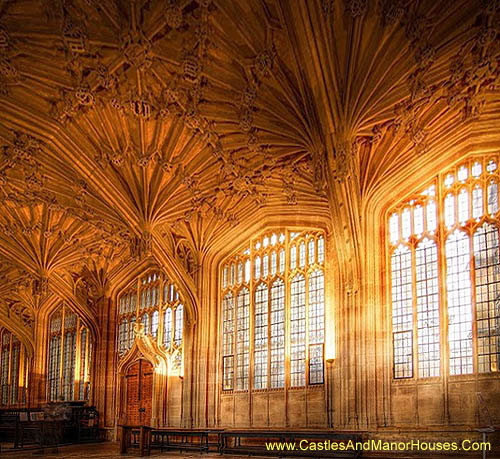 |
Divinity School, Unversity of Oxford |
||||||||
 |
Peel Castle, St Patrick's Isle, Isle of Man, UK
The castle was built in the 11th century by the Vikings, under the rule of Magnus II of the Isle of Man (King Magnus Barelegs). In the early 14th century, the majority of the present walls and towers were built, primarily from local red sandstone. After the Vikings, the castle continued to be used by the Church due to the cathedral built along with the castle – the cathedral church of the Sodor Diocese. The cathedral was eventually abandoned in the 18th century.
New defensive positions were added as late as 1860. The buildings within the castle are now mostly ruined, but the outer walls remain intact. Excavations in 1982-87 revealed an extensive graveyard as well as the remains of Magnus Bareleg's original wooden fort. The most spectacular finds were the 10th century grave of "The Pagan Lady" which included a fine example of a Viking necklace and a cache of silver coins dating from about 1030. The Castle's most famous resident is reputed to be Moddey Dhoo, a Black Dog ghost .The castle is now owned by Manx National Heritage and is open to visitors during the summer. Peel Castle is a possible location of the Arthurian Avalon. |
||||||||
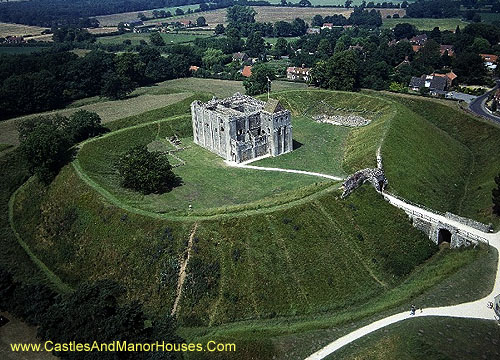 |
Castle Rising Castle Rising, Norfolk, England.
Castle Rising is a ruined medieval fortification built soon after 1138 by William d'Aubigny II, who had risen through the ranks of the Anglo-Norman nobility to become the Earl of Arundel.
It was inherited by William's descendants before passing into the hands of the de Montalt family in 1243. The Montalts later sold the castle to Queen Isabella, who lived there after her fall from power in 1330. Isabella extended the castle buildings and enjoyed a regal lifestyle, entertaining her son, Edward III on several occasions. After her death, it was granted to Edward, the Black Prince, to form part of the Duchy of Cornwall. It was later aqcired by the Howard family.
English Heritage took over control of the castle in 1983 and continued to operate it as a tourist attraction. The castle is protected by UK law as an ancient monument and a grade I listed building. It remains in the custody of English Heritage, but since 1998 has been managed by its owner, Baron Howard of Rising. |
||||||||
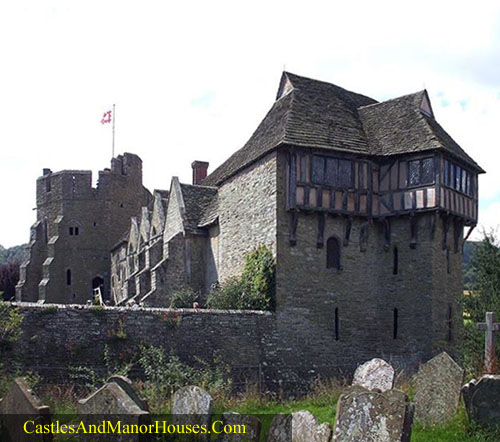 |
Stokesay Castle Shropshire, ENGLAND
Stokesay Castle is a fortified manor house built in the late 13th century by Laurence of Ludlow, then the leading wool merchant in England. Laurence's descendants continued to own the castle until the 16th century. By the time of the outbreak of the English Civil War in 1641, Stokesay was owned by William Craven, the first Earl of Craven and a supporter of King Charles I. After the Royalist war effort collapsed in 1645, Parliamentary forces besieged the castle in June and quickly forced its garrison to surrender. Parliament ordered the property to be slighted, but only minor damage was done to the walls, allowing Stokesay to continue to be used as a house by the Baldwyn family until the end of the 17th century.
Architecturally, Stokesay Castle is one of the best-preserved medieval fortified manor houses in England. The castle comprises a walled, moated enclosure, with an entrance way through a 17th-century timber and plaster gatehouse. Inside, the courtyard faces a stone hall and solar block, protected by two stone towers. The hall features a 13th-century wooden-beamed ceiling, and 17th-century carved figures ornament the gatehouse and the solar. The castle was never intended to be a serious military fortification, but its style was intended to echo the much larger castles being built by Edward I in North Wales. Originally designed as a prestigious home, the castle has changed very little since the 13th century, and is a rare example of a near complete set of medieval buildings. |
||||||||
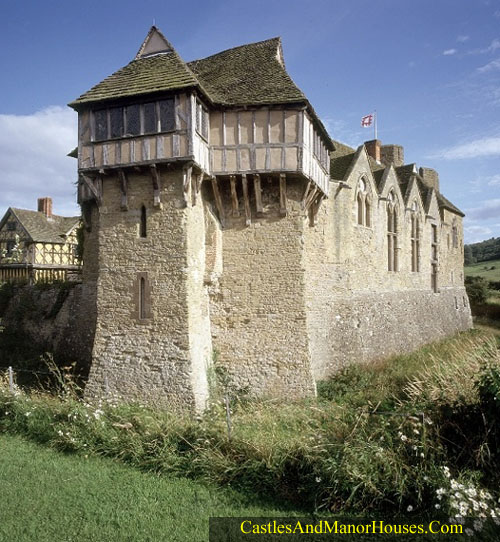 |
Stokesay Castle Shropshire, ENGLAND
Stokesay Castle is a fortified manor house built in the late 13th century by Laurence of Ludlow, then the leading wool merchant in England. Laurence's descendants continued to own the castle until the 16th century. By the time of the outbreak of the English Civil War in 1641, Stokesay was owned by William Craven, the first Earl of Craven and a supporter of King Charles I. After the Royalist war effort collapsed in 1645, Parliamentary forces besieged the castle in June and quickly forced its garrison to surrender. Parliament ordered the property to be slighted, but only minor damage was done to the walls, allowing Stokesay to continue to be used as a house by the Baldwyn family until the end of the 17th century.
Architecturally, Stokesay Castle is one of the best-preserved medieval fortified manor houses in England. The castle comprises a walled, moated enclosure, with an entrance way through a 17th-century timber and plaster gatehouse. Inside, the courtyard faces a stone hall and solar block, protected by two stone towers. The hall features a 13th-century wooden-beamed ceiling, and 17th-century carved figures ornament the gatehouse and the solar. The castle was never intended to be a serious military fortification, but its style was intended to echo the much larger castles being built by Edward I in North Wales. Originally designed as a prestigious home, the castle has changed very little since the 13th century, and is a rare example of a near complete set of medieval buildings. |
||||||||
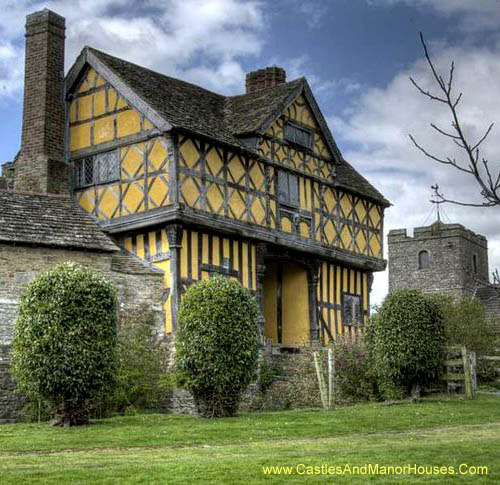 |
Main entrance Stokesay Castle Shropshire, England |
||||||||
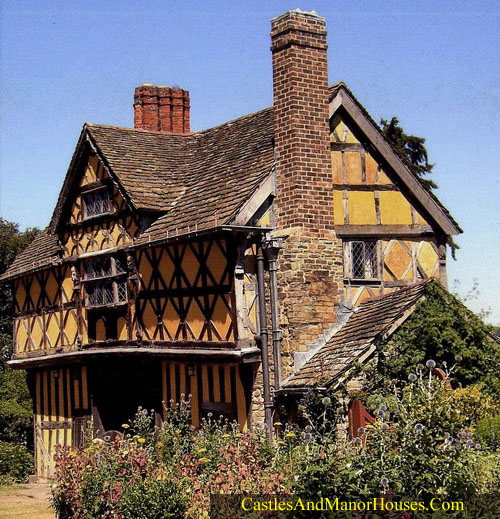 |
Gatehouse Stokesay Castle Shropshire, ENGLAND
Stokesay Castle is a fortified manor house built in the late 13th century by Laurence of Ludlow, then the leading wool merchant in England. Laurence's descendants continued to own the castle until the 16th century. By the time of the outbreak of the English Civil War in 1641, Stokesay was owned by William Craven, the first Earl of Craven and a supporter of King Charles I. After the Royalist war effort collapsed in 1645, Parliamentary forces besieged the castle in June and quickly forced its garrison to surrender. Parliament ordered the property to be slighted, but only minor damage was done to the walls, allowing Stokesay to continue to be used as a house by the Baldwyn family until the end of the 17th century.
Architecturally, Stokesay Castle is one of the best-preserved medieval fortified manor houses in England. The castle comprises a walled, moated enclosure, with an entrance way through a 17th-century timber and plaster gatehouse. Inside, the courtyard faces a stone hall and solar block, protected by two stone towers. The hall features a 13th-century wooden-beamed ceiling, and 17th-century carved figures ornament the gatehouse and the solar. The castle was never intended to be a serious military fortification, but its style was intended to echo the much larger castles being built by Edward I in North Wales. Originally designed as a prestigious home, the castle has changed very little since the 13th century, and is a rare example of a near complete set of medieval buildings. |
||||||||
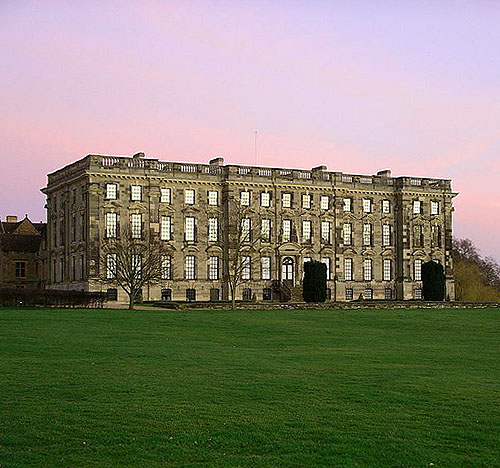 |
Stoneleigh Abbey Stoneleigh, Warwickshire, England.
Stoneleigh Abbey is a large country mansion and a Grade I listed building. An Abbey here was founded by the Cistercians in 1154. but little trace remains of the Abbey buildings except for the 14th century Gatehouse. After the Dissolution of the Monasteries the estate was acquired by Sir Thomas Leigh, Lord Mayor of London in 1558. He built a house on the site of the monastic buildings, which forms the north and west wings of the present house. It was the home of the Leigh family from 1561 to 1990. |
||||||||
 |
Grand Gallery Strawberry Hill House Twickenham, London, England
Strawberry Hill House, often referred to simply as Strawberry Hill, is the Gothic Revival villa built by Horace Walpole from 1749. It as so influential that is the exemplar of a style known as "Strawberry Hill Gothic". It prefigured the nineteenth-century Gothic revival.
Walpole rebuilt the existing house in stages in 1749, 1760, 1772 and 1776. He progressively added gothic features such as towers and battlements outside and elaborate decoration inside to create "gloomth" to suit his collection of antiquarian objects.
After a £9 million, two-year-long restoration, Strawberry Hill House reopened to the public in 2010 |
||||||||
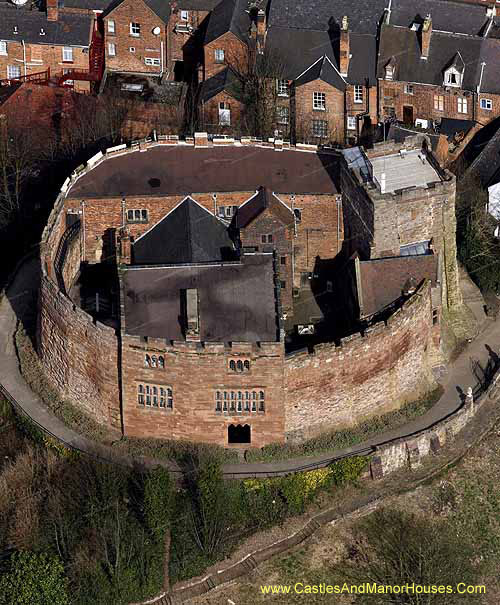 |
Tamworth Castle Tamworth, Staffordshire, England.
Overlooking the River Tame, the site has been fortified since Anglo-Saxon times, when Ethelfleda, the Mercian Queen, built a burh to defend against Danes in 913. It served as a residence of the Mercian kings. Rebuilt and enlarged by the Normans, it is today one of the best preserved Norman motte-and-bailey castles in England.
Today it is a monument of local council philistinism, surrounded by ugly modern housing.
The present castle was constructed by the Norman invaders in the 1080s, occupying the south western part of the earlier burh. It dates primarily from the 11th and 12th century and was constructed in the typical Norman motte and bailey fashion. Following the Norman Invasion of 1066, Tamworth was granted to Robert Despenser, steward to William the Conqueror. Robert died childless and so the castle passed to a daughter of his brother Urse d'Abetot's, Matilida, who married Robert de Marmion. The Marmion family, from Fontenay-le-Marmion, Normandy, held the castle for 6 generations from c.1100 - 1294. The Marmion family were hereditary champions to the Dukes of Normandy and then of the new Kings of England. This role required them to offer a ceremonial challenge to those who would oppose the King.
Tamworth Castle is a Grade I listed building. |
||||||||
 |
Tofte Manor from sunken garden Tofte Manor Souldrop Road, Sharnbrook, Bedfordshire MK44 1HH, England |
||||||||
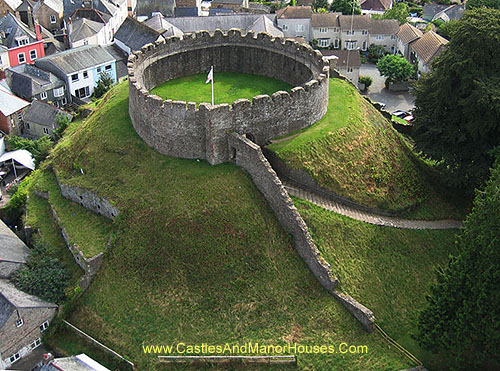 |
Totnes Castle Castle Street, Totnes, Devon TQ9 5NU, England
The castle occupies a commanding position atop a large hill above the town, and guards the approach to three valleys, including that of the River Dart.
The surviving stone keep and curtain wall date from around the 14th century. Totnes Castle is one of the best preserved examples of a Norman motte and bailey castle in England |
||||||||
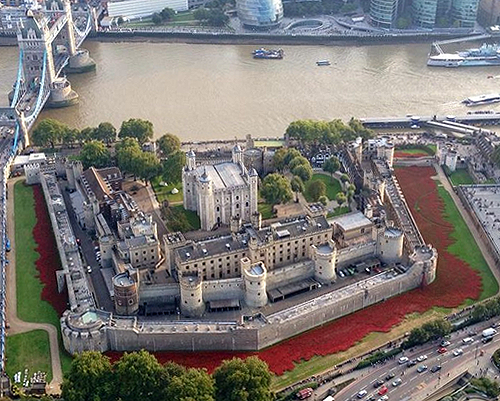 |
Ceramic poppies at the Tower of London, 2014. Tower of London, London, England
Installation “Blood Swept Lands and Seas of Red”, marking the centenary of the outbreak of the First World War. Created by ceramic artist Paul Cummins, with setting by stage designer Tom Piper, 888,246 ceramic poppies progressively fill the Tower’s moat, each poppy representing a British fatality during the First World War. |
||||||||
 |
The White Tower, Tower of London Borough of Tower Hamlets, London, England
Her Majesty's Royal Palace and Fortress, known as the Tower of London, is a historic castle located on the north bank of the River Thames in central London. It is separated from the eastern edge of the square mile of the City of London by Tower Hill. It was founded towards the end of 1066 as part of the Norman Conquest of England.
The castle was used as a prison from 1100 (Ranulf Flambard) until 1952 (Kray twins), although that was not its primary purpose. It served as a royal residence. As a whole, the Tower is a complex of several buildings set within two concentric rings of defensive walls and a moat. There were several phases of expansion, mainly under Kings Richard the Lionheart, Henry III, and Edward I in the 12th and 13th centuries. The general layout established by the late 13th century remains despite later activity on the site.
The Tower of London has played a prominent role in English history. It was besieged several times and controlling it has been important to controlling the country. The Tower has served variously as an armoury, a treasury, a menagerie, the home of the Royal Mint, a public records office, and the home of the Crown Jewels of the United Kingdom.
it is cared for by the charity Historic Royal Palaces and is protected as a World Heritage Site. |
||||||||
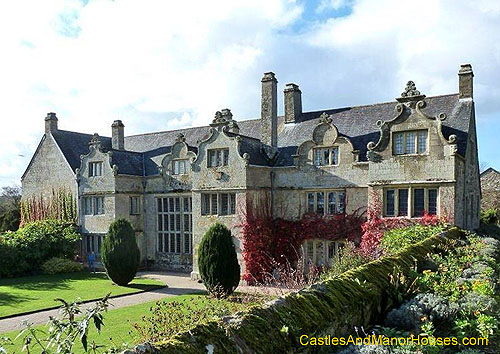 |
Trerice Kestle Mill, near Newquay, Cornwall, England
Trerice is an Elizabethan manor house, The building features a main south-east facing range of 'E'-plan abutting a south-west range containing two earlier phases.
Phase I consisted of a tower house with low north-west block. This was extended early in the 16th century, probably by 'Jack of Tilbury', to include a 2-storey range to the south-east of the earlier tower, together now forming the bulky south wing.
Sir John IV Arundell, High Sheriff of Cornwall added the main range of the E-plan circa 1570-1573. At the period it was fashionable build house with an E shaped plan (E for Queen Elizabeth)
The house, along with its surrounding garden, is a National Trust property. |
||||||||
 |
Warkworth Castle Warkworth, Northumberland, England
It is an example of a Norman Motte and bailey castle.
Both town and castle occupy a loop of the River Coquet, less than a mile from England's north-east coast.
Traditionally the castle's construction has been ascribed to Prince Henry of Scotland in the mid-12th century, but it may have been built by King Henry II of England when he took control of England's northern counties. |
||||||||
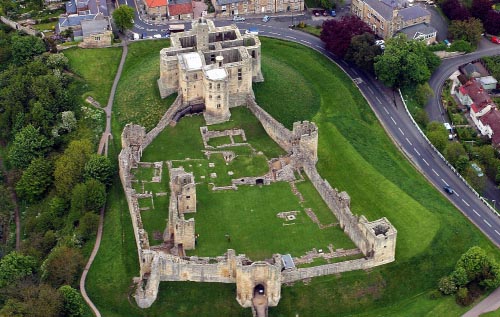 |
Warkworth Castle Warkworth, Northumberland, England
It is an example of a Norman Motte and bailey castle.
Both town and castle occupy a loop of the River Coquet, less than a mile from England's north-east coast.
Traditionally the castle's construction has been ascribed to Prince Henry of Scotland in the mid-12th century, but it may have been built by King Henry II of England when he took control of England's northern counties. |
||||||||
 |
Walmer Castle Walmer, Kent, England.
Walmer Castle was built by Henry VIII in 1539–1540 as an artillery fortress to counter the threat of invasion from Catholic France and Spain. It was part of his programme to create a chain of coastal defences along England's coast known as the Device Forts or as Henrician Castles.
It was one of three forts constructed to defend the Downs, an area of safe anchorage protected by the Goodwin Sands. The other forts were at Deal and Sandown. The castle is now owned and managed by English Heritage. |
||||||||
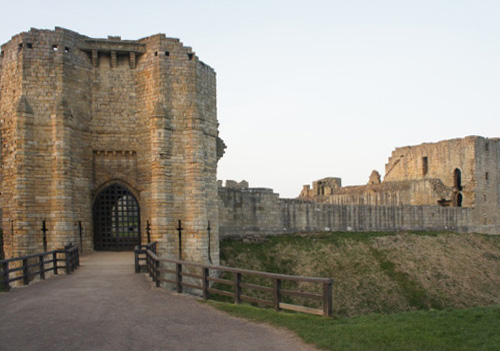 |
Warkworth Castle Warkworth, Northumberland, England
It is an example of a Norman Motte and bailey castle.
Both town and castle occupy a loop of the River Coquet, less than a mile from England's north-east coast.
Traditionally the castle's construction has been ascribed to Prince Henry of Scotland in the mid-12th century, but it may have been built by King Henry II of England when he took control of England's northern counties. |
||||||||
 |
The Angel Roof at Westminster Hall (looking East), Westminster, London, England
The Angel Roof at Westminster Hall is a hammerbeam roof. A hammerbeam roof is a decorative, open timber roof truss typical of English Gothic architecture and has been called "...the most spectacular endeavour of the English Medieval carpenter."
Hammerbeam roofs are traditionally timber framed, using short beams projecting from the wall on which the rafters land, essentially a tie beam which has the middle cut out. These short beams are called hammer-beams and give this truss its name. |
||||||||
.jpg) |
Windsor Castle Windsor, Berkshire, England
Windsor Castle is a royal residence notable for its long association with the English and later British royal family and also for its architecture. The original castle was built in the 11th century after the Norman invasion by William the Conqueror. Since the time of Henry I, it has been used by succeeding monarchs and is the longest-occupied palace in Europe. More than five hundred people live and work in Windsor Castle.
Originally designed to protect Norman dominance around the outskirts of London, and to oversee a strategically important part of the River Thames, Windsor Castle was built as a motte and bailey, with three wards surrounding a central mound. Gradually replaced with stone fortifications, the castle withstood a prolonged siege during the First Barons' War at the start of the 13th century. Henry III built a luxurious royal palace within the castle during the middle of the century, and Edward III went further, rebuilding the palace to produce an even grander set of buildings. Edward's core design lasted through the Tudor period, during which Henry VIII and Elizabeth I made increasing use of the castle as a royal court and centre for diplomatic entertainment. |
||||||||
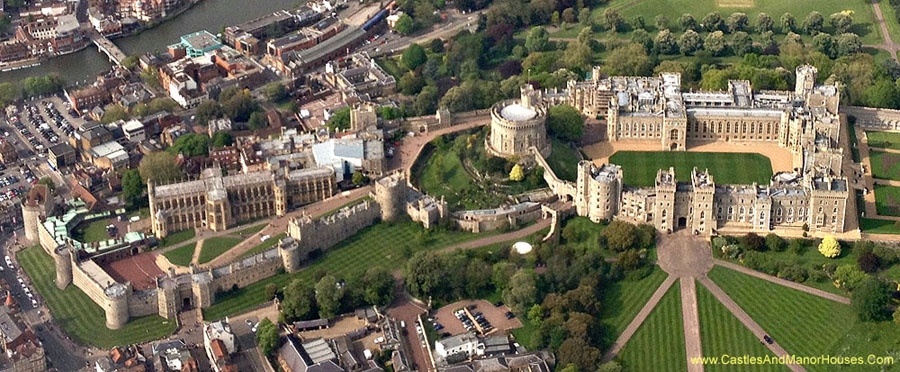 |
|||||||||
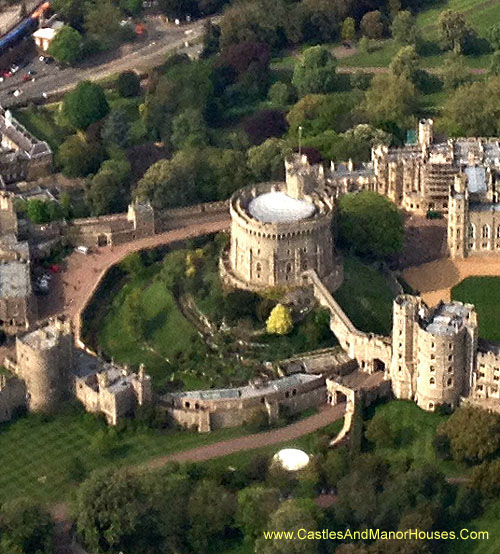 |
Windsor Castle Windsor, Berkshire, England
Windsor Castle is a royal residence notable for its long association with the English and later British royal family and also for its architecture. The original castle was built in the 11th century after the Norman invasion by William the Conqueror. Since the time of Henry I, it has been used by succeeding monarchs and is the longest-occupied palace in Europe. More than five hundred people live and work in Windsor Castle.
Originally designed to protect Norman dominance around the outskirts of London, and to oversee a strategically important part of the River Thames, Windsor Castle was built as a motte and bailey, with three wards surrounding a central mound. Gradually replaced with stone fortifications, the castle withstood a prolonged siege during the First Barons' War at the start of the 13th century. Henry III built a luxurious royal palace within the castle during the middle of the century, and Edward III went further, rebuilding the palace to produce an even grander set of buildings. Edward's core design lasted through the Tudor period, during which Henry VIII and Elizabeth I made increasing use of the castle as a royal court and centre for diplomatic entertainment.
Windsor Castle survived the tumultuous period of the English Civil War, when it was used as a military headquarters for Parliamentary forces and a prison for Charles I. During the Restoration, Charles II rebuilt much of Windsor Castle with the help of architect Hugh May, creating a set of extravagant, Baroque interiors that are still admired. After a period of neglect during the 18th century, George III and George IV renovated and rebuilt Charles II's palace at colossal expense, producing the current design of the State Apartments, full of Rococo, Gothic and Baroque furnishings. Victoria made minor changes to the castle, which became the centre for royal entertainment for much of her reign. Windsor Castle was used as a refuge for the royal family during the bombing campaigns of the Second World War and survived a fire in 1992. |
||||||||
 |
state room Windsor Castle, Windsor, Berkshire, ENGLAND
Windsor Castle is a royal residence notable for its long association with the English and later British royal family and also for its architecture. The original castle was built in the 11th century after the Norman invasion by William the Conqueror. Since the time of Henry I, it has been used by succeeding monarchs and is the longest-occupied palace in Europe. More than five hundred people live and work in Windsor Castle.
Originally designed to protect Norman dominance around the outskirts of London, and to oversee a strategically important part of the River Thames, Windsor Castle was built as a motte and bailey, with three wards surrounding a central mound. Gradually replaced with stone fortifications, the castle withstood a prolonged siege during the First Barons' War at the start of the 13th century. Henry III built a luxurious royal palace within the castle during the middle of the century, and Edward III went further, rebuilding the palace to produce an even grander set of buildings. Edward's core design lasted through the Tudor period, during which Henry VIII and Elizabeth I made increasing use of the castle as a royal court and centre for diplomatic entertainment. |
||||||||
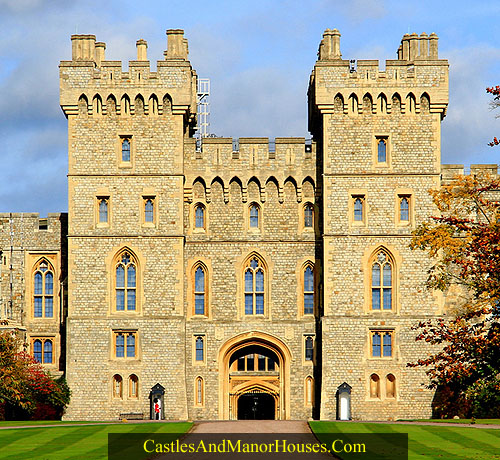 |
Windsor Castle, Windsor, Berkshire, England
Windsor Castle, Windsor, Berkshire, ENGLAND
Windsor Castle is a royal residence notable for its long association with the English and later British royal family and also for its architecture. The original castle was built in the 11th century after the Norman invasion by William the Conqueror. Since the time of Henry I, it has been used by succeeding monarchs and is the longest-occupied palace in Europe. More than five hundred people live and work in Windsor Castle.
Originally designed to protect Norman dominance around the outskirts of London, and to oversee a strategically important part of the River Thames, Windsor Castle was built as a motte and bailey, with three wards surrounding a central mound. Gradually replaced with stone fortifications, the castle withstood a prolonged siege during the First Barons' War at the start of the 13th century. Henry III built a luxurious royal palace within the castle during the middle of the century, and Edward III went further, rebuilding the palace to produce an even grander set of buildings. Edward's core design lasted through the Tudor period, during which Henry VIII and Elizabeth I made increasing use of the castle as a royal court and centre for diplomatic entertainment. |
||||||||
|
|
|||||||||
|
|
|||||||||
|
|
|||||||||
|
|
|||||||||
|
|
|||||||||
|
|
|
|
|||||||
|
|
|||||||||
| :::: Link to us :::: Castle and Manor Houses Resources ::: © C&MH 2010-2014 ::: contact@castlesandmanorhouses.com ::: Advertising ::: |